2025-02-21#29: Russian Orthodox Approaches to Secularity in the Petrine Reforms of the Early Eighteenth Century
Sebastian Rimestad
 Since the tenth century, the main religious force in Russia has been Orthodox Christianity. This branch of the Christian Church developed differently from its Western counterpart, Latin Christianity, after the geopolitical paths of the Western and Eastern Roman Empires diverged following the Migration Period in Late Antiquity. The different developments in the Christian East and West also led to distinct path dependencies, which informed the conceptualisation of the boundaries between the religious and the secular spheres. This working paper probes these differences, via an analysis of two important texts from early modern Russia: Feofan Prokopovich’s 1718 Palm Sunday sermon about “The Dignity and Power of the Sovereign,” and his 1721 “Spiritual Regulation.” By focusing on these two documents, whose conceptual foundations arguably shaped the structure of the Russian church for two centuries, the paper provides a first glimpse into the official discourse of religion and its discontents in early eighteenth-century Russia.
Since the tenth century, the main religious force in Russia has been Orthodox Christianity. This branch of the Christian Church developed differently from its Western counterpart, Latin Christianity, after the geopolitical paths of the Western and Eastern Roman Empires diverged following the Migration Period in Late Antiquity. The different developments in the Christian East and West also led to distinct path dependencies, which informed the conceptualisation of the boundaries between the religious and the secular spheres. This working paper probes these differences, via an analysis of two important texts from early modern Russia: Feofan Prokopovich’s 1718 Palm Sunday sermon about “The Dignity and Power of the Sovereign,” and his 1721 “Spiritual Regulation.” By focusing on these two documents, whose conceptual foundations arguably shaped the structure of the Russian church for two centuries, the paper provides a first glimpse into the official discourse of religion and its discontents in early eighteenth-century Russia.
Download pdf 2024-11-27#28: Desecularisation of the State and Sacred Secularism: Politics and Religion in Mexico within the Latin-American Context
Carlos Nazario Mora Duro
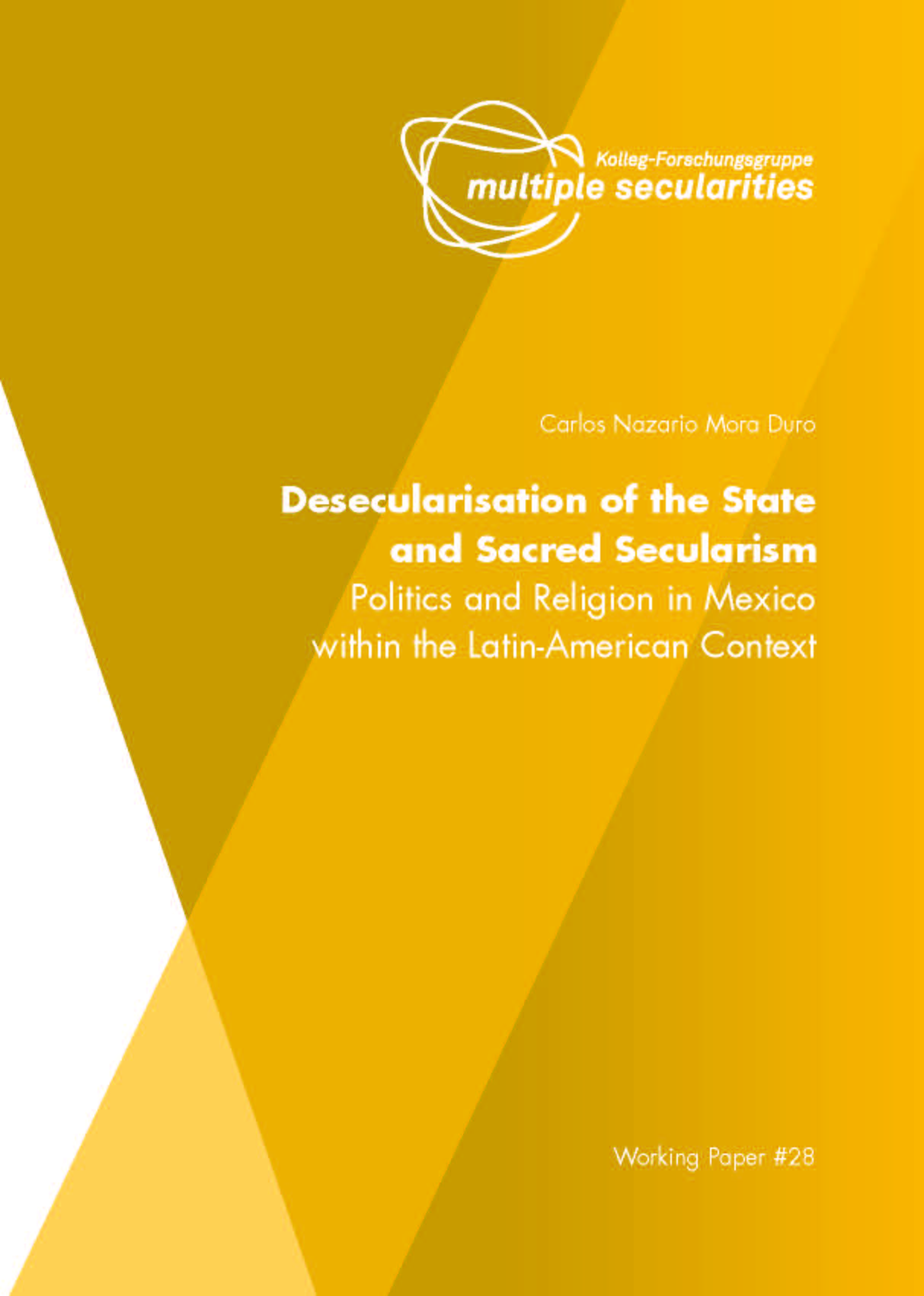 Recent political conflicts have highlighted the influence of religious actors and organisations in the public spheres of Latin American countries. The Pentecostal Evangelical movement in Colombia was crucial to the success of the ‘No’ campaign in the 2016 plebiscite, in which citizens rejected the peace agreement between the government and the Revolutionary Armed Forces of Colombia (FARC). In Brazil, evangelical congregations played a central role during the 2016 impeachment of President Dilma Rousseff, and in the subsequent rise of Jair Bolsonaro. In Bolivia, evangelical leaders and conservative elements of the Catholic Church alike supported the 2019 coup against Evo Morales. In Mexico, the 2018 rise of left-wing President Andrés Manuel López Obrador has been accompanied by criticism of his proximity to religious actors, and his moralising political rhetoric. Some authors have even described the Mexican leader as a politician with messianic overtones.
Against this background, it is worth asking what the implications of the recent convergence between politics and religion in Latin America are. To answer this question, we must avoid the oversimplification of suggesting a singular process of religious advance in Latin American societies. It is important to instead highlight the complex interaction of: 1) the process of secularisation (involving both secularism and secularity) in the region, 2) the trend towards pluralisation of the religious field, 3) the concurrence of counter-secular expressions in the public space, 4) and the occurrence of conflict in the political arena.
Although secularisation in Latin America historically emerged as a process of distinction of the political sphere, I argue here that it is currently expressed as a democratic ideal through the process of the dispersal in society of certain secular notions favouring state autonomy, especially in those countries that maintain the secularism legally established in the nineteenth century. My approach raises the question of how the boundaries between religion and the state in Mexico have been defined historically, and what the current status of this differentiation is. I also advance the analytical notion of sacred secularism, as a principle and expectation in the public space.
Recent political conflicts have highlighted the influence of religious actors and organisations in the public spheres of Latin American countries. The Pentecostal Evangelical movement in Colombia was crucial to the success of the ‘No’ campaign in the 2016 plebiscite, in which citizens rejected the peace agreement between the government and the Revolutionary Armed Forces of Colombia (FARC). In Brazil, evangelical congregations played a central role during the 2016 impeachment of President Dilma Rousseff, and in the subsequent rise of Jair Bolsonaro. In Bolivia, evangelical leaders and conservative elements of the Catholic Church alike supported the 2019 coup against Evo Morales. In Mexico, the 2018 rise of left-wing President Andrés Manuel López Obrador has been accompanied by criticism of his proximity to religious actors, and his moralising political rhetoric. Some authors have even described the Mexican leader as a politician with messianic overtones.
Against this background, it is worth asking what the implications of the recent convergence between politics and religion in Latin America are. To answer this question, we must avoid the oversimplification of suggesting a singular process of religious advance in Latin American societies. It is important to instead highlight the complex interaction of: 1) the process of secularisation (involving both secularism and secularity) in the region, 2) the trend towards pluralisation of the religious field, 3) the concurrence of counter-secular expressions in the public space, 4) and the occurrence of conflict in the political arena.
Although secularisation in Latin America historically emerged as a process of distinction of the political sphere, I argue here that it is currently expressed as a democratic ideal through the process of the dispersal in society of certain secular notions favouring state autonomy, especially in those countries that maintain the secularism legally established in the nineteenth century. My approach raises the question of how the boundaries between religion and the state in Mexico have been defined historically, and what the current status of this differentiation is. I also advance the analytical notion of sacred secularism, as a principle and expectation in the public space.
Download pdf 2023-04-19#27: Populism, Religion, and Secularity in Latin America and Europe: A Comparative Perspective
Roberto Blancarte
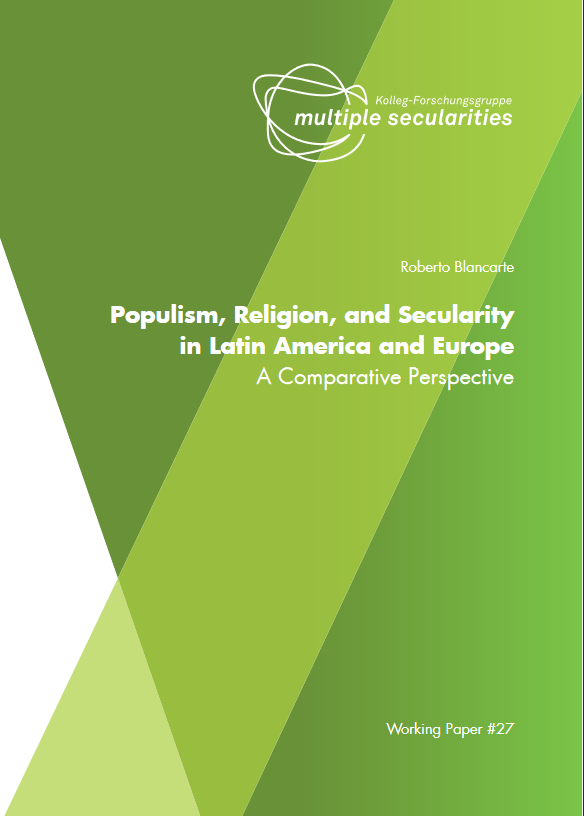 Much has been written in the past few decades about populism that most scholars approaching the subject feel obliged to begin by justifying their writing of yet another text. In this paper, the situation is somewhat different: whilst our analytical gaze is cast upon populism (and fascism, as a precursor or closely related social phenomenon), this is only indirectly the case. Our primary focus is, instead, on the relationship that populism has with religion and secularity. Or, more precisely, the relationships of diverse populisms with different religiosities and various secularities. While the religious and the secular are mentioned in numerous studies about populism, these topics have rarely been adequately elaborated. Even when they are discussed, they are treated only in a marginal way. The purpose of this work is, therefore, to highlight the complex and multi-faceted way that populisms in Europe and Latin America have related to religion and religiosity. A second, parallel objective of this work is to reflect on the particular relationships populism establishes with different understandings of the secular, specifically within the political sphere, i.e. ‘political secularity.’ Following the differentiation paradigm, another term one might see used for this is ‘laicity’ (laïcité in French, laicidad in Spanish). I understand this to refer specifically to the secularisation of the state and the areas of society which come under its control.
Much has been written in the past few decades about populism that most scholars approaching the subject feel obliged to begin by justifying their writing of yet another text. In this paper, the situation is somewhat different: whilst our analytical gaze is cast upon populism (and fascism, as a precursor or closely related social phenomenon), this is only indirectly the case. Our primary focus is, instead, on the relationship that populism has with religion and secularity. Or, more precisely, the relationships of diverse populisms with different religiosities and various secularities. While the religious and the secular are mentioned in numerous studies about populism, these topics have rarely been adequately elaborated. Even when they are discussed, they are treated only in a marginal way. The purpose of this work is, therefore, to highlight the complex and multi-faceted way that populisms in Europe and Latin America have related to religion and religiosity. A second, parallel objective of this work is to reflect on the particular relationships populism establishes with different understandings of the secular, specifically within the political sphere, i.e. ‘political secularity.’ Following the differentiation paradigm, another term one might see used for this is ‘laicity’ (laïcité in French, laicidad in Spanish). I understand this to refer specifically to the secularisation of the state and the areas of society which come under its control.
Download pdf 2022-12-19#26: Abu Hamid al-Ghazali and Niklas Luhmann: Boundary Negotiations Between Religion and Science in the Abbasid Empire
Dietrich Jung
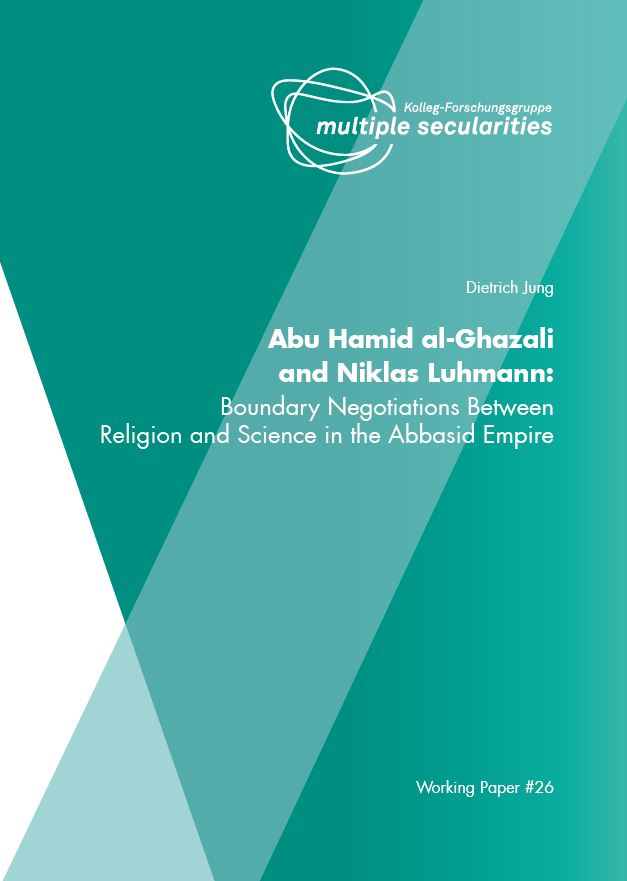 In the context of my involvement with the CASHSS Multiple Secularities – Beyond the West, Beyond Modernities’ research programme, I chose Ghazali’s autobiography, and in particular his “crisis of indecision,” as an example of a pre-modern negotiation of the boundaries of religion at the micro level. The research programme suggests employing the analytical concept of secularity to investigate both non-Western and pre-modern forms of secularity, in terms of conceptual distinctions and institutional differentiations between religious and non-religious social spheres. In this essay, I would like to propose a method of pursuing these goals from my own theoretical perspective. More specifically, I will argue that in Ghazali’s reflections on spiritual religiosity, theology, philosophy and science, we can discern the individual engagement of a prominent Muslim thinker with emerging communicative realms. In the Modern Systems Theory of Niklas Luhmann, these realms are taken to represent functionally differentiated subsystems of modern society.
In the context of my involvement with the CASHSS Multiple Secularities – Beyond the West, Beyond Modernities’ research programme, I chose Ghazali’s autobiography, and in particular his “crisis of indecision,” as an example of a pre-modern negotiation of the boundaries of religion at the micro level. The research programme suggests employing the analytical concept of secularity to investigate both non-Western and pre-modern forms of secularity, in terms of conceptual distinctions and institutional differentiations between religious and non-religious social spheres. In this essay, I would like to propose a method of pursuing these goals from my own theoretical perspective. More specifically, I will argue that in Ghazali’s reflections on spiritual religiosity, theology, philosophy and science, we can discern the individual engagement of a prominent Muslim thinker with emerging communicative realms. In the Modern Systems Theory of Niklas Luhmann, these realms are taken to represent functionally differentiated subsystems of modern society.
Download pdf 2022-08-03#24: Sagas and Secularity: The (Re)Construction of Secular Literature in 20th-century Iceland
Haraldur Hreinsson
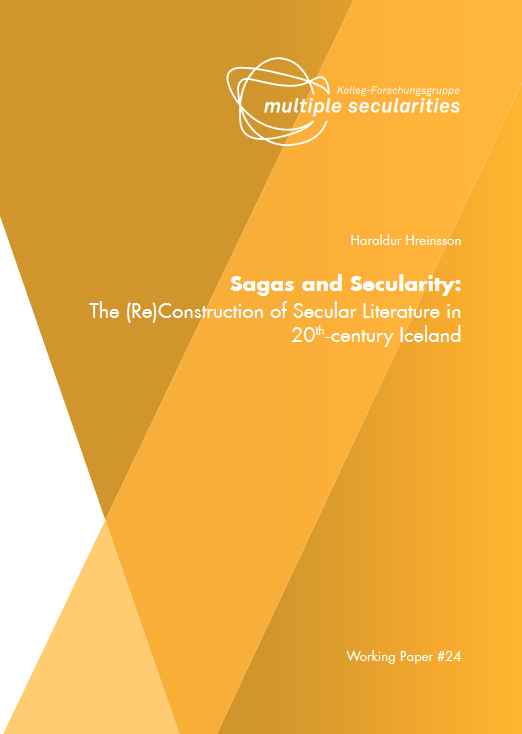 The study of secularity in Iceland has so far largely been restricted to institutional differentiation, alongside legal aspects of the relationship between the state and the country’s national church. This paper approaches the formation of secularity in the country from a different angle. Adopting a research perspective shaped by both cultural history and sociology of culture, it investigates the role of the Icelandic sagas, and the medieval culture which spawned them, in the development of secularity in Iceland. Instead of looking at the processes through which Christian religion came to be separated from other spheres of society, it probes the discourses legitimising such a separation. It pays special attention to the reception and understanding of the sagas and the medieval culture which produced them, and further asks how they provided a background against which a secular culture could be imagined, both in the past and for the present.
The study of secularity in Iceland has so far largely been restricted to institutional differentiation, alongside legal aspects of the relationship between the state and the country’s national church. This paper approaches the formation of secularity in the country from a different angle. Adopting a research perspective shaped by both cultural history and sociology of culture, it investigates the role of the Icelandic sagas, and the medieval culture which spawned them, in the development of secularity in Iceland. Instead of looking at the processes through which Christian religion came to be separated from other spheres of society, it probes the discourses legitimising such a separation. It pays special attention to the reception and understanding of the sagas and the medieval culture which produced them, and further asks how they provided a background against which a secular culture could be imagined, both in the past and for the present.
Download pdf 2022-06-28#25: Hindu Politics in Service of Secularism
Vanya Vaidehi Bhargav
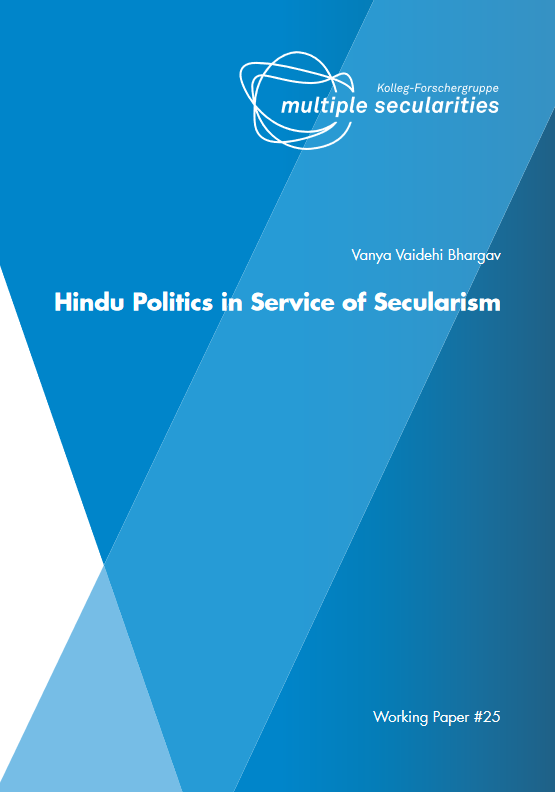 This paper explores the political thought during the 1920s of Lala Lajpat Rai (1865–1928), a prominent anti-colonial nationalist. It outlines the historical context under which a secular politics became vital for Rai, and elaborates the intricate internal texture of his complex, often fluid vision of secularism. The second half of the paper explores the theoretical implications of Rai’s dynamic position. It illustrates how Lajpat Rai simultaneously articulated both a Hindu communal politics and a vision of secularism. By so doing, this paper challenges the long-drawn strict dichotomy between Hindu politics or Hindu ‘communalism’ and Indian secularism. Yet, the paper also pushes back against revisionist scholarship which, in challenging assumptions of strict mutual exclusivity between Indian secularism and Hindu communalism, has tended to overlook and undermine meaningful distinctions that still exist between these categories. This paper insists on the need to retain and respect the analytical distinctions between the two categories, even while recognising that they do not always exist in relation to each other as a strict dichotomy. Unearthing a hitherto-hidden Indian secularism articulated by this ‘Hindu communal’ politician, the paper will briefly explore the ways in which Rai’s complex position overlaps with, and is distinct from, Western variants of secularism, India’s constitutional secularism, and the Gandhian-Nehruvian vision, the latter of which became hegemonic till the 1970s. The paper ends by, very briefly, comparing Lajpat Rai’s position with Hindutva nationalism – a major influence on the contemporary Hindu right – and by reflecting on the relationship between the Hindu right and secularism.
This paper explores the political thought during the 1920s of Lala Lajpat Rai (1865–1928), a prominent anti-colonial nationalist. It outlines the historical context under which a secular politics became vital for Rai, and elaborates the intricate internal texture of his complex, often fluid vision of secularism. The second half of the paper explores the theoretical implications of Rai’s dynamic position. It illustrates how Lajpat Rai simultaneously articulated both a Hindu communal politics and a vision of secularism. By so doing, this paper challenges the long-drawn strict dichotomy between Hindu politics or Hindu ‘communalism’ and Indian secularism. Yet, the paper also pushes back against revisionist scholarship which, in challenging assumptions of strict mutual exclusivity between Indian secularism and Hindu communalism, has tended to overlook and undermine meaningful distinctions that still exist between these categories. This paper insists on the need to retain and respect the analytical distinctions between the two categories, even while recognising that they do not always exist in relation to each other as a strict dichotomy. Unearthing a hitherto-hidden Indian secularism articulated by this ‘Hindu communal’ politician, the paper will briefly explore the ways in which Rai’s complex position overlaps with, and is distinct from, Western variants of secularism, India’s constitutional secularism, and the Gandhian-Nehruvian vision, the latter of which became hegemonic till the 1970s. The paper ends by, very briefly, comparing Lajpat Rai’s position with Hindutva nationalism – a major influence on the contemporary Hindu right – and by reflecting on the relationship between the Hindu right and secularism.
Download pdf 2021-02-23#23: Religion, Culture, and the Secular: The Case of Islam
Gudrun Krämer
 Why jump into a sea, where everything is seemingly fleeting, floating, and fluid? There is not a single concept that offers solid ground to stand on: ‘religion’ is problematic, ‘culture’ elusive, ‘secularity’ contested, and ‘Islam’ one big question mark. ‘Identity’, to name that which looms so large in modern contexts, fares no better. Yet jump we must if we are to do more than critique conceptualisations that we consider flawed, and instead provide what is expected of academics: critical reflection that does justice to the subject at hand, while at the same time speaking to wider intellectual, moral, and political concerns. This paper contributes to the debate on multiple secularities by discussing conceptualisations of religion and culture and their relevance to articulations of secularity ‘in Islam’. Written from the perspective of historically grounded Islamic studies, with a focus on the period up to 1500, this paper nonetheless addresses current concerns, for while the secular and hints at secularity can be identified in pre-modern Muslim majority contexts, they only emerged as themes of theoretically informed debate in the modern period.
Why jump into a sea, where everything is seemingly fleeting, floating, and fluid? There is not a single concept that offers solid ground to stand on: ‘religion’ is problematic, ‘culture’ elusive, ‘secularity’ contested, and ‘Islam’ one big question mark. ‘Identity’, to name that which looms so large in modern contexts, fares no better. Yet jump we must if we are to do more than critique conceptualisations that we consider flawed, and instead provide what is expected of academics: critical reflection that does justice to the subject at hand, while at the same time speaking to wider intellectual, moral, and political concerns. This paper contributes to the debate on multiple secularities by discussing conceptualisations of religion and culture and their relevance to articulations of secularity ‘in Islam’. Written from the perspective of historically grounded Islamic studies, with a focus on the period up to 1500, this paper nonetheless addresses current concerns, for while the secular and hints at secularity can be identified in pre-modern Muslim majority contexts, they only emerged as themes of theoretically informed debate in the modern period.
Download pdf 2020-09-09#22: Preliminary Findings and Outlook of the CASHSS “Multiple Secularities – Beyond the West, Beyond Modernities”
Christoph Kleine and Monika Wohlrab-Sahr
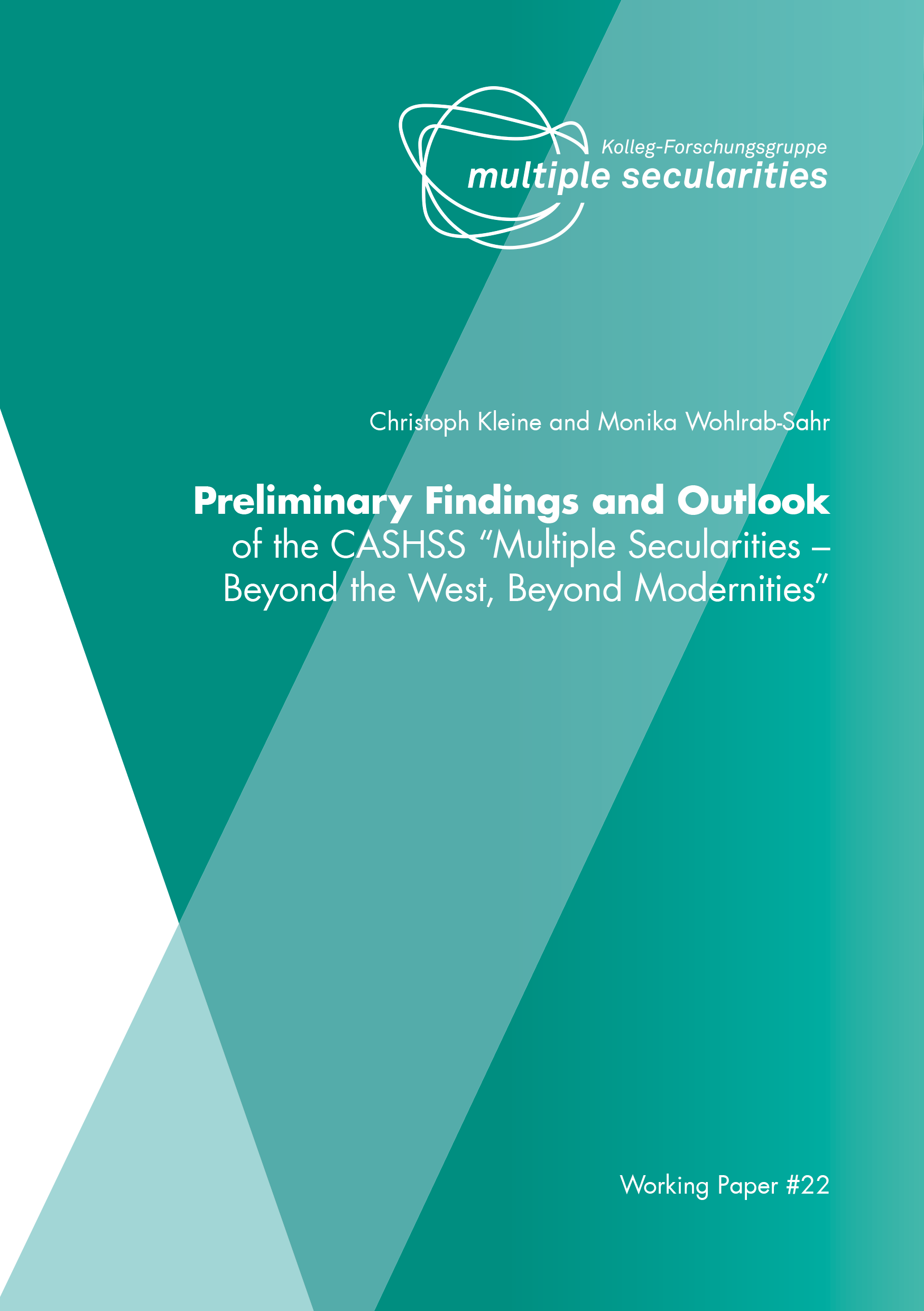 In its initial research project description, the Centre for Advanced Studies in Humanities and Social Sciences (CASHSS) took a position on the longstanding academic and public debates on secularism, secularisation, and secularity. In doing so, The CASHSS took up the concept of Multiple Secularities and developed it further. Based on the hypothesis that distinguishing and differentiating practices are not an exclusive sign of Western modernity, we decided to systematically explore regions beyond the ‘Western world’, and in doing so expand our research remit beyond that on which Taylor had focused. We focused on regions that have been culturally shaped by Islam (the MENA region, Indonesia, India), as well as on Asia, which necessarily involved some overlap. These regional contexts differed historically and still do so today in terms of their propensity for conflict over boundary demarcation and the way in which relationships are established between the religious and the non-religious. What they have in common is that the application of the term ‘religion’ to the respective socio-cultural traditions is highly controversial. Exploring these regions brought different religious traditions as well as experiences of the confrontation with the Western world into focus, suggesting the prospect of instructive comparisons.
In its initial research project description, the Centre for Advanced Studies in Humanities and Social Sciences (CASHSS) took a position on the longstanding academic and public debates on secularism, secularisation, and secularity. In doing so, The CASHSS took up the concept of Multiple Secularities and developed it further. Based on the hypothesis that distinguishing and differentiating practices are not an exclusive sign of Western modernity, we decided to systematically explore regions beyond the ‘Western world’, and in doing so expand our research remit beyond that on which Taylor had focused. We focused on regions that have been culturally shaped by Islam (the MENA region, Indonesia, India), as well as on Asia, which necessarily involved some overlap. These regional contexts differed historically and still do so today in terms of their propensity for conflict over boundary demarcation and the way in which relationships are established between the religious and the non-religious. What they have in common is that the application of the term ‘religion’ to the respective socio-cultural traditions is highly controversial. Exploring these regions brought different religious traditions as well as experiences of the confrontation with the Western world into focus, suggesting the prospect of instructive comparisons.
Download pdf 2020-02-27#21: The City as Secular Space and Religious Territory Accommodating Religious Activism in Urban India
Ursula Rao
 For many bureaucrats, temples are nuisances, traffic obstructions, acts of landgrabbing, or means of political assertion that contribute to inter-religious tensions. By contrast, builders, trustees or worshippers defend temples as spaces of divine manifestation, as responding to religious needs and providing space for religious festivals and community activity. In this article, I use the case study of the establishment of a controversial goddess temple in Bhopal to shed light on a fundamental rift between two ideal-type approaches to the city – as a secular place and as religious territory.
For many bureaucrats, temples are nuisances, traffic obstructions, acts of landgrabbing, or means of political assertion that contribute to inter-religious tensions. By contrast, builders, trustees or worshippers defend temples as spaces of divine manifestation, as responding to religious needs and providing space for religious festivals and community activity. In this article, I use the case study of the establishment of a controversial goddess temple in Bhopal to shed light on a fundamental rift between two ideal-type approaches to the city – as a secular place and as religious territory.
Download pdf 2020-02-20#20: Tea for Interreligious Harmony? Cause Marketing as a New Field of Experimentation with Visual Secularity in India
Nadja-Christina Schneider
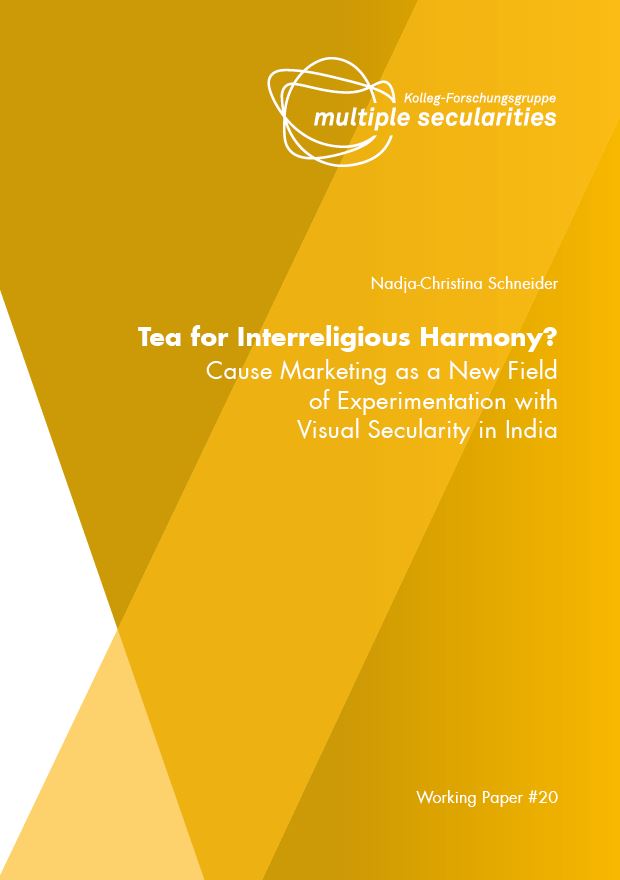 This working paper is part of a larger research project on emerging visualities and imaginaries of living together in plurality and on equal terms. Against the background of growing majoritarianism in India and the normalization of violence against religious minorities and marginalized communities, the search for new visual forms and aesthetic means to counter increasing divisiveness and conflict has acquired exceptional urgency. It is a search pursued by many and in multiple directions, occasionally even in
the realm of marketing and advertising which is the focus of this article. The larger project considers documentaries, fictional films and transmedia interventions in order to understand how different actors seek to create new visualities that are markedly different from earlier form(at)s used to visually mediate the normative project of political secularism for many decades, but nevertheless draw on the idea that secularity is a mode of living together and socially interacting in plural societies.
This working paper is part of a larger research project on emerging visualities and imaginaries of living together in plurality and on equal terms. Against the background of growing majoritarianism in India and the normalization of violence against religious minorities and marginalized communities, the search for new visual forms and aesthetic means to counter increasing divisiveness and conflict has acquired exceptional urgency. It is a search pursued by many and in multiple directions, occasionally even in
the realm of marketing and advertising which is the focus of this article. The larger project considers documentaries, fictional films and transmedia interventions in order to understand how different actors seek to create new visualities that are markedly different from earlier form(at)s used to visually mediate the normative project of political secularism for many decades, but nevertheless draw on the idea that secularity is a mode of living together and socially interacting in plural societies.
Download pdf 2019-12-17#19: Religions, Charity, and Non-State Welfare in Contemporary China
André Laliberté
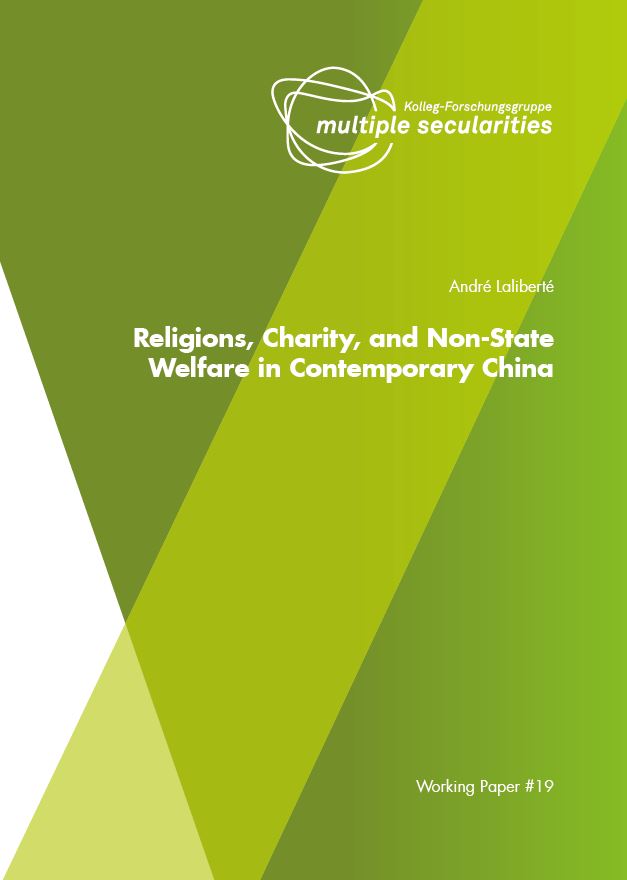 This paper is part of broader research on social welfare, understood in its broadest sense as social security, education, and health care, which the state has taken over gradually from religions as it has established its authority and thereby the ontological and the teleological legitimacy of secularity as a pillar of modernity. The paper explores the Chinese Communist Party’s evolving attitude towards religious affairs and philanthropy.
This paper is part of broader research on social welfare, understood in its broadest sense as social security, education, and health care, which the state has taken over gradually from religions as it has established its authority and thereby the ontological and the teleological legitimacy of secularity as a pillar of modernity. The paper explores the Chinese Communist Party’s evolving attitude towards religious affairs and philanthropy.
Download pdf 2019-12-16#18: Kurdish Alevism: Creating New Ways of Practising the Religion
Ahmet Kerim Gültekin
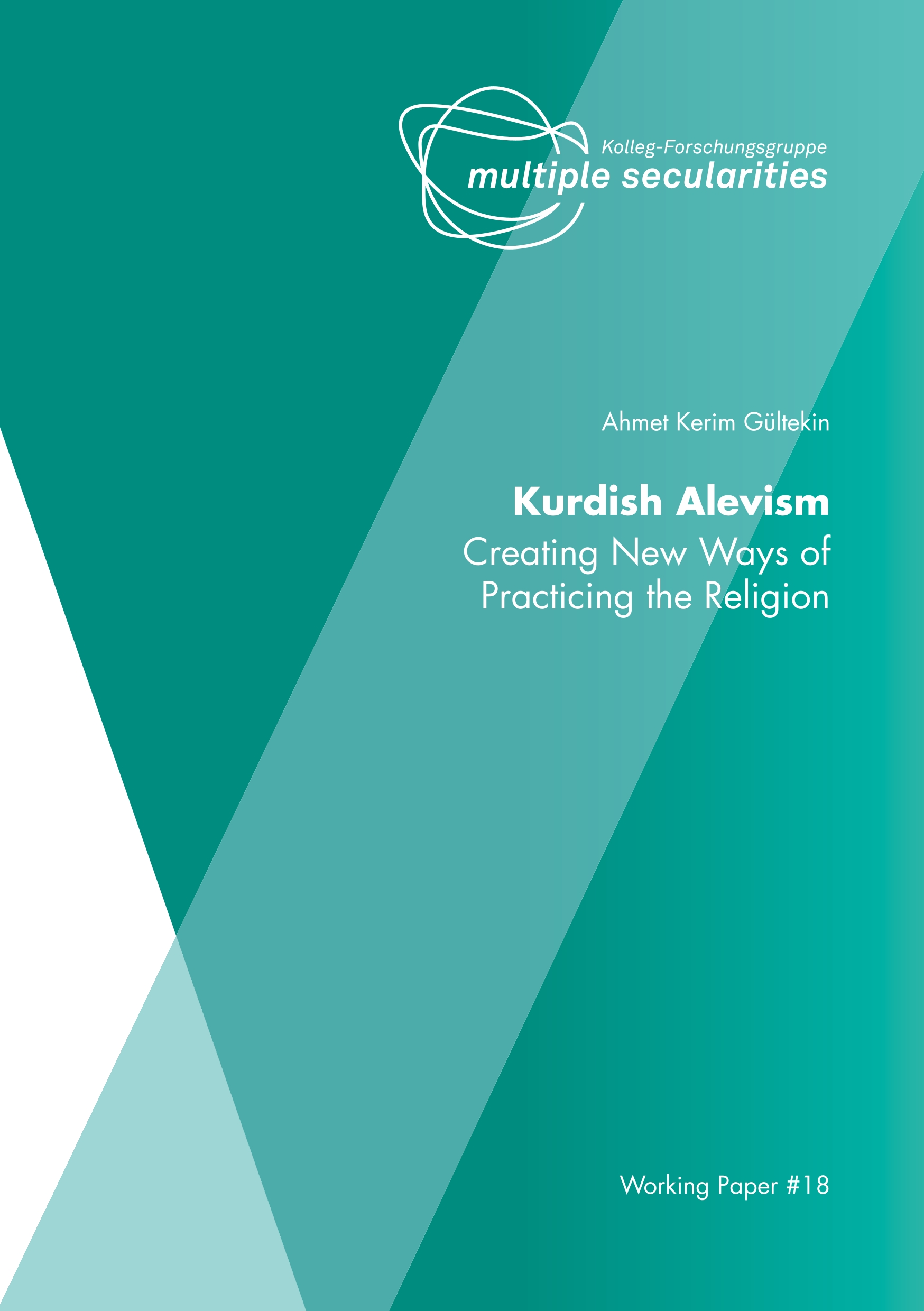 This paper will examine the transformation dynamics of social change in Kurdish Alevi communities, while mostly focusing on the increasing sociopolitical and religious role of talips. Until the end of the 20th century, the socio-religious structure of Kurdish Alevis was dominated by two hereditary social positions, much like a caste system: on the one hand, the members of the sacred lineages (ocaks), who embody the religious authority, and on the other hand, the talips who are subordinated to the sacred lineages. This socio-religious structure provided a framework for Kurdish Alevi socioreligious organisations.
This paper will examine the transformation dynamics of social change in Kurdish Alevi communities, while mostly focusing on the increasing sociopolitical and religious role of talips. Until the end of the 20th century, the socio-religious structure of Kurdish Alevis was dominated by two hereditary social positions, much like a caste system: on the one hand, the members of the sacred lineages (ocaks), who embody the religious authority, and on the other hand, the talips who are subordinated to the sacred lineages. This socio-religious structure provided a framework for Kurdish Alevi socioreligious organisations.
Download pdf 2019-10-24#17: On Subjectivity and Secularity in Axial Age China
Heiner Roetz
 The Centre for Advanced Studies in the Humanities and Social Sciences “Multiple Secularities – Beyond the West, Beyond Modernities” deals with topics, at least some of which I have myself dealt with throughout my sinological and philosophical life. I came to Frankfurt in autumn 1968: fascinated by Frankfurt School, I started studying sociology, but to my surprise this did not mean studying Critical Theory. Instead, it meant going through quite a conventional education in the social sciences, and moreover, it meant studying economics and statistics. This was not quite what I expected and after a few semesters I changed my major to philosophy. In need of a second subject, I chose sinology because of some vague interest in foreign cultures, and also because of the news coming from China at that time. It was the time of the Cultural Revolution that exerted a certain fascination on the German student movement especially since its revolutionary rhetoric differed so remarkably from the ossified language of Eastern European Marxist orthodoxy. So, like many members of my generation, I began to develop an interest in revolutionary China that was definitely not shared by my philosophy teachers – they were skeptical, at least to some extent.
The Centre for Advanced Studies in the Humanities and Social Sciences “Multiple Secularities – Beyond the West, Beyond Modernities” deals with topics, at least some of which I have myself dealt with throughout my sinological and philosophical life. I came to Frankfurt in autumn 1968: fascinated by Frankfurt School, I started studying sociology, but to my surprise this did not mean studying Critical Theory. Instead, it meant going through quite a conventional education in the social sciences, and moreover, it meant studying economics and statistics. This was not quite what I expected and after a few semesters I changed my major to philosophy. In need of a second subject, I chose sinology because of some vague interest in foreign cultures, and also because of the news coming from China at that time. It was the time of the Cultural Revolution that exerted a certain fascination on the German student movement especially since its revolutionary rhetoric differed so remarkably from the ossified language of Eastern European Marxist orthodoxy. So, like many members of my generation, I began to develop an interest in revolutionary China that was definitely not shared by my philosophy teachers – they were skeptical, at least to some extent.
Download pdf 2019-10-23#16: Religion-based ‘Personal’ Law, Legal Pluralism and Secularity: A Field View of Adjudication of Muslim Personal Law in India
Suchandra Ghosh and Anindita Chakrabarti
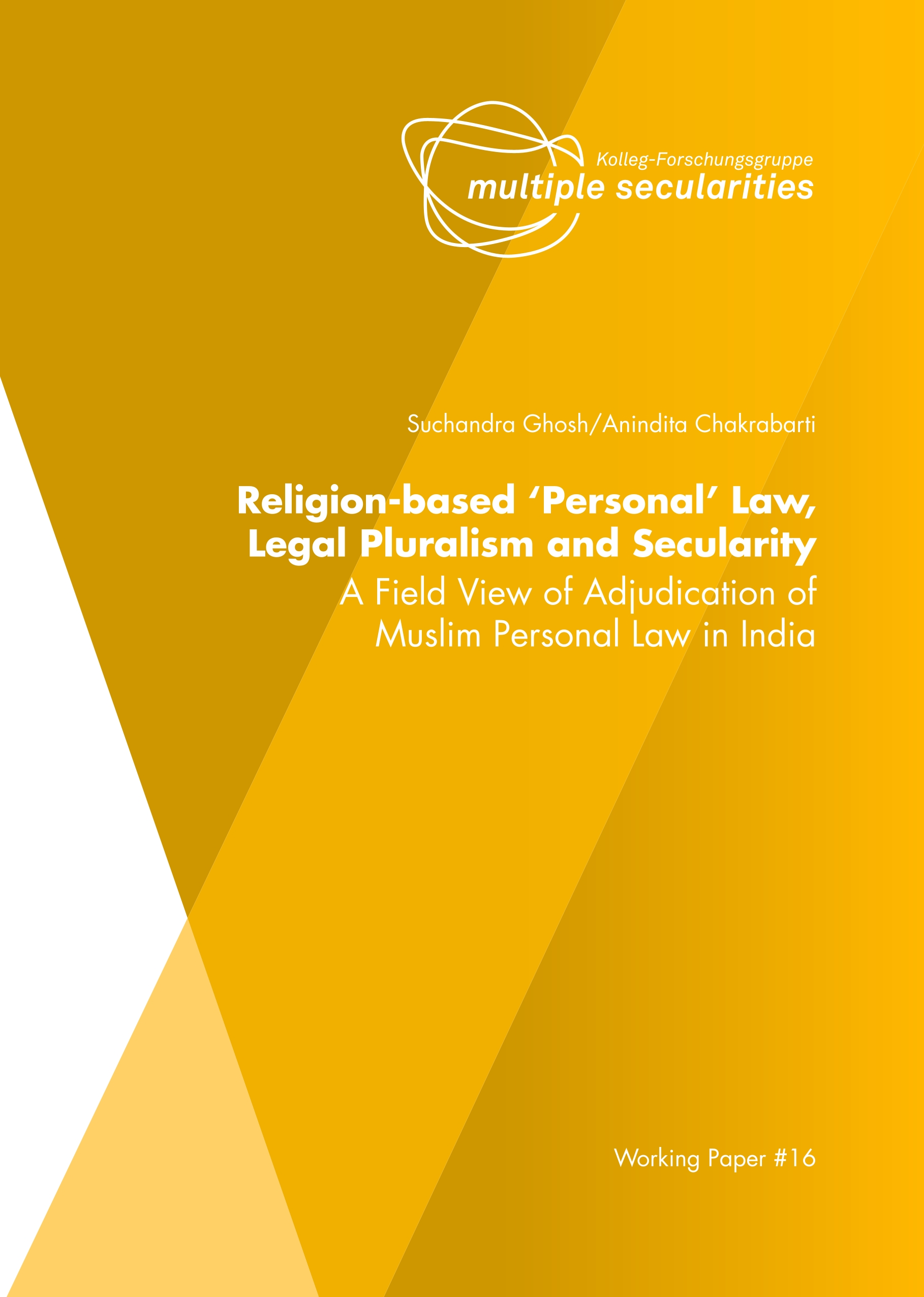 In this paper, we show how this plural legal landscape is negotiated by litigants, especially women, and thereby illustrate the procedural interplay between civil and religious courts through this adjudication process. The ethnography of adjudication at the Darul-Qaza situated in a large Muslim neighbourhood in Kanpur and the institution’s intersections with the societal (We mean the tribunals that function at the neighbourhood or community level) secular courts show how Muslim personal law functions. In this paper, we identify both the links between the Darul-Qaza and civil courts, and the processes of evidence making and legal reasoning that are integral to this interlegality. We argue that the issue of personal law should be understood within the post-colonial legal structure of India and with a good understanding of the processes through which disputes in the delicate area of family, affect and kinship are addressed and resolved. The above case shows how resolution occurs in a family dispute when plural institutional mechanisms are at work. This paper explores the adjudication process at a Darul-Qaza to understand how religion-based family laws get constituted as litigants seek both religious counsel and civil authority.
In this paper, we show how this plural legal landscape is negotiated by litigants, especially women, and thereby illustrate the procedural interplay between civil and religious courts through this adjudication process. The ethnography of adjudication at the Darul-Qaza situated in a large Muslim neighbourhood in Kanpur and the institution’s intersections with the societal (We mean the tribunals that function at the neighbourhood or community level) secular courts show how Muslim personal law functions. In this paper, we identify both the links between the Darul-Qaza and civil courts, and the processes of evidence making and legal reasoning that are integral to this interlegality. We argue that the issue of personal law should be understood within the post-colonial legal structure of India and with a good understanding of the processes through which disputes in the delicate area of family, affect and kinship are addressed and resolved. The above case shows how resolution occurs in a family dispute when plural institutional mechanisms are at work. This paper explores the adjudication process at a Darul-Qaza to understand how religion-based family laws get constituted as litigants seek both religious counsel and civil authority.
Download pdf 2019-10-22#15: Secularism and its Enemies
Aziz Al-Azmeh
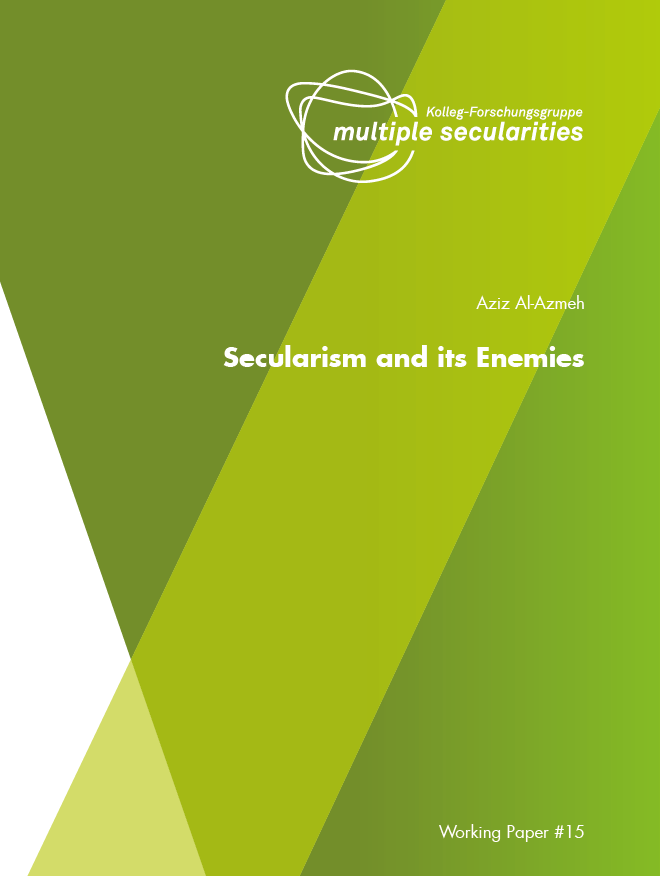 This Working Paper is intended to suggest a fairly simple contention concerning a number of interconnected propositions made in connection with the debates on modernity and secularism. None of these propositions is particularly novel, nor is this the first time that they have been put forward. The simple contention I wish to start with concerns Islamism, often brought out emblematically when secularism and modernity are discussed. Like other self-consciously retrogressive identitarian motifs, ideas, sensibilities, moods and inflections of politics that sustain differentialist culturalism and are sustained by it conceptually, Islamism has come to gain very considerable political and social traction over the past quarter of a century. This had until recently reached the extent that it, as a perceptual grid of social and cultural purchase relating to societies and countries that many associate with Islam, has become hegemonic in public discussions about society and politics and, until recently, hegemonic without serious challenge. It has also been crucial for triggering the latest round of antisecular discussions and polemics.
This Working Paper is intended to suggest a fairly simple contention concerning a number of interconnected propositions made in connection with the debates on modernity and secularism. None of these propositions is particularly novel, nor is this the first time that they have been put forward. The simple contention I wish to start with concerns Islamism, often brought out emblematically when secularism and modernity are discussed. Like other self-consciously retrogressive identitarian motifs, ideas, sensibilities, moods and inflections of politics that sustain differentialist culturalism and are sustained by it conceptually, Islamism has come to gain very considerable political and social traction over the past quarter of a century. This had until recently reached the extent that it, as a perceptual grid of social and cultural purchase relating to societies and countries that many associate with Islam, has become hegemonic in public discussions about society and politics and, until recently, hegemonic without serious challenge. It has also been crucial for triggering the latest round of antisecular discussions and polemics.
Download pdf 2019-10-21#14: Pathways, Contingencies, and the Secular in Iran’s First Revolution
Nader Sohrabi
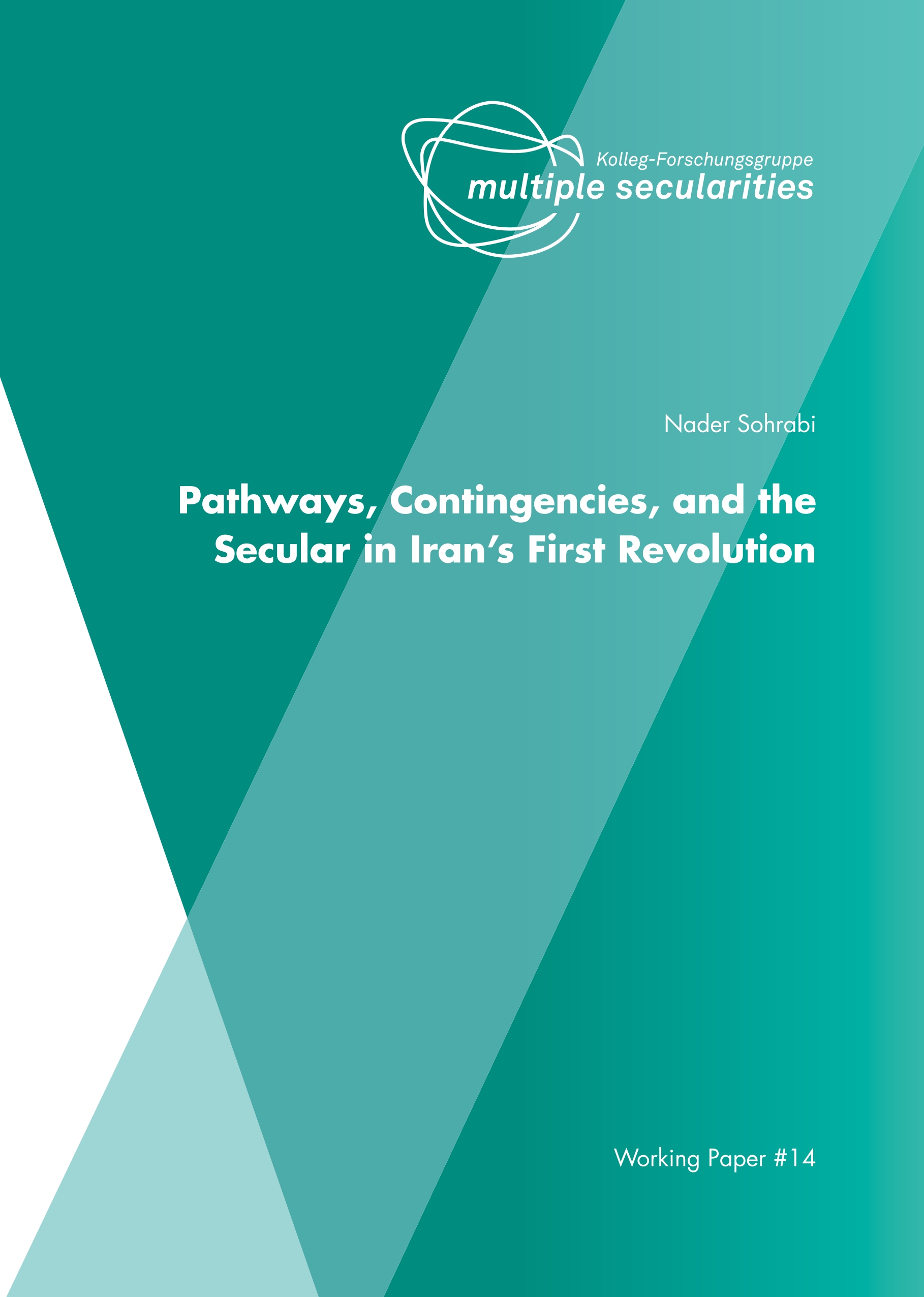 Iran’s constitutional revolution of 1906 is arguably the most significant turn toward the secular in its modern history. I start this investigation by making a conceptual distinction between secularism and secularity. Here, secularism is defined as the ideologically-driven separation of religion and state according to an agenda, a blueprint, a model, that could be indigenously, or externally informed and is achieved with the assistance of the modern state and explicit political motivations. Secularity, on the other hand, is expressed in terms of a non-ideological separation that comes about unintentionally. In some accounts, this separation may take on evolutionary connotations in terms of the natural separation of functions as a result of the growing complexity of a natural organism or social system. What I have in mind here is a separation of functions that is agent-driven but the secularity that emerges is both unintentional and unideological. In other words, separation is attained not because actors consciously distinguish between the religious and the political at the conceptual level, or experience a wholesale shift in belief systems, but because some new contexts open novel avenues for pursuing goals or interests that are experienced by actors as more effective than previously undifferentiated ones, without necessarily effecting conscious change, or any change, in belief systems.
Iran’s constitutional revolution of 1906 is arguably the most significant turn toward the secular in its modern history. I start this investigation by making a conceptual distinction between secularism and secularity. Here, secularism is defined as the ideologically-driven separation of religion and state according to an agenda, a blueprint, a model, that could be indigenously, or externally informed and is achieved with the assistance of the modern state and explicit political motivations. Secularity, on the other hand, is expressed in terms of a non-ideological separation that comes about unintentionally. In some accounts, this separation may take on evolutionary connotations in terms of the natural separation of functions as a result of the growing complexity of a natural organism or social system. What I have in mind here is a separation of functions that is agent-driven but the secularity that emerges is both unintentional and unideological. In other words, separation is attained not because actors consciously distinguish between the religious and the political at the conceptual level, or experience a wholesale shift in belief systems, but because some new contexts open novel avenues for pursuing goals or interests that are experienced by actors as more effective than previously undifferentiated ones, without necessarily effecting conscious change, or any change, in belief systems.
Download pdf 2019-07-25#13: Indonesian Secularities. On the Influence of the State-Islam Relationship on Legal and Political Developments
Muchamad Ali Safa'at
 This working paper aims to analyse the relationship between state and religion (in this case, Islam) in political and legal developments in Indonesia from colonial times to the present, and to determine the model of Indonesian secularity within the multiple secularities approach. The legal and political developments relating to the relationship between the state and Islam in Indonesia are understood to be the products of societal debate as well as instruments for solving particular societal problems, guided by certain guiding ideas that shape Indonesian secularity.
This working paper aims to analyse the relationship between state and religion (in this case, Islam) in political and legal developments in Indonesia from colonial times to the present, and to determine the model of Indonesian secularity within the multiple secularities approach. The legal and political developments relating to the relationship between the state and Islam in Indonesia are understood to be the products of societal debate as well as instruments for solving particular societal problems, guided by certain guiding ideas that shape Indonesian secularity.
Download pdf 2019-07-24#12: Drawing Lines in a Mandala. A Sketch of Boundaries Between Religion and Politics in Bhutan
Dagmar Schwerk
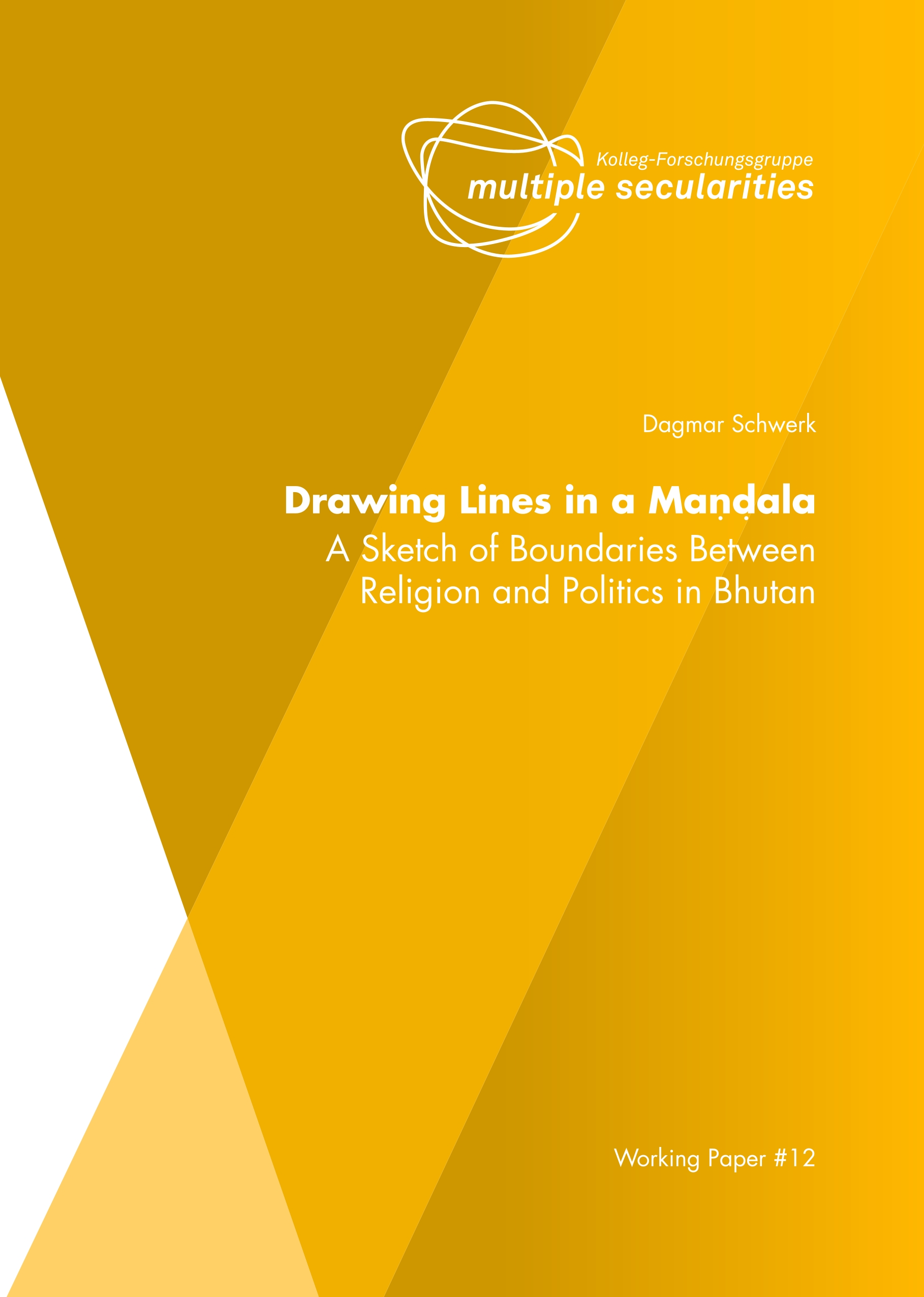 In the first half of the seventeenth century, three major Buddhist governments that combined a twofold religious and political structure under a Buddhist ruler were established in the Tibetan cultural area (Joint Twofold System of Governance). In 1625/26, Bhutan was united under the rule of a charismatic Tibetan Buddhist master, Tibet and Sikkim followed, both in 1642 – although with significant differences in their respective institutionalisation. The Working Paper presents findings of the specific and unique case example of pre-modern Bhutan to yield benefit for further interdisciplinary discourses about secularity, religion, and modernity in contemporary Bhutan – paying thereby tribute to the complexity of this field of research. Besides for Bhutan, this analytical framework can be adapted for further research about different pre-modern formations of the Joint Twofold System of Governance in the Tibetan cultural area as a whole.
In the first half of the seventeenth century, three major Buddhist governments that combined a twofold religious and political structure under a Buddhist ruler were established in the Tibetan cultural area (Joint Twofold System of Governance). In 1625/26, Bhutan was united under the rule of a charismatic Tibetan Buddhist master, Tibet and Sikkim followed, both in 1642 – although with significant differences in their respective institutionalisation. The Working Paper presents findings of the specific and unique case example of pre-modern Bhutan to yield benefit for further interdisciplinary discourses about secularity, religion, and modernity in contemporary Bhutan – paying thereby tribute to the complexity of this field of research. Besides for Bhutan, this analytical framework can be adapted for further research about different pre-modern formations of the Joint Twofold System of Governance in the Tibetan cultural area as a whole.
Download pdf 2019-07-22#11: ‘Unbiased Scholars’ and ‘Superficial Intellectuals’: Was there a Public Culture between Europe and Inner Asia in the Long 19th Century?
Matthew W. King
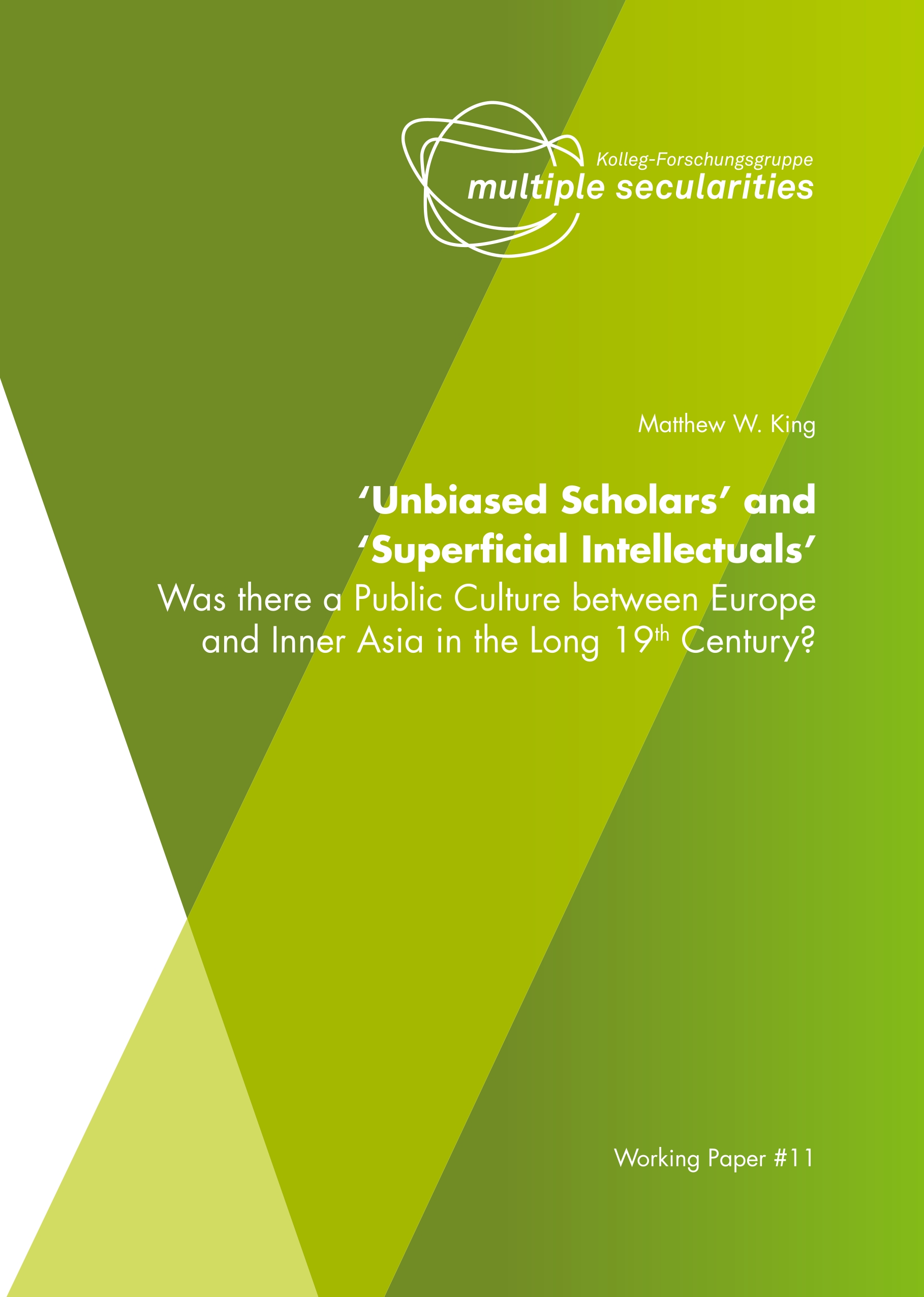 This working paper explores what I consider to be a tenuous but persistent form of “public culture” extending between Inner Asia and Europe over the course of the eighteenth and, especially, nineteenth centuries. This “stranger relationality,” as Michael Warner would have it, was mediated by new forms and routes of Eurasianist textual circulation. In this late imperial period, spread along the frontiers of the Qing, Tsarist, and British empires, Tibetan, Mongolian, and Buryat monks read works by European and East Asian intellectuals on all manner of technical knowledge, and began writing not to fellow scholastics or local readers, but to a global community of “the knowledgeable” (Tib. mkhas pa; Mon. baγsi, nomčin).
This paper introduces the social sites of my sources, the Buddhist monastic colleges that spanned the Sino-Russian frontiers, and provides a few examples of synthetic scholastic products that emerged in this previously unstudied form of Eurasianist public culture (c. 1750–1930s). I will also share some preliminary arguments about the ways that practices of secularity amongst the actors led directly to the creation of the modern public sphere, civil society, and ironically, revolutionary institutional forms and models of history that had violently erased scholastic culture from public life.
This working paper explores what I consider to be a tenuous but persistent form of “public culture” extending between Inner Asia and Europe over the course of the eighteenth and, especially, nineteenth centuries. This “stranger relationality,” as Michael Warner would have it, was mediated by new forms and routes of Eurasianist textual circulation. In this late imperial period, spread along the frontiers of the Qing, Tsarist, and British empires, Tibetan, Mongolian, and Buryat monks read works by European and East Asian intellectuals on all manner of technical knowledge, and began writing not to fellow scholastics or local readers, but to a global community of “the knowledgeable” (Tib. mkhas pa; Mon. baγsi, nomčin).
This paper introduces the social sites of my sources, the Buddhist monastic colleges that spanned the Sino-Russian frontiers, and provides a few examples of synthetic scholastic products that emerged in this previously unstudied form of Eurasianist public culture (c. 1750–1930s). I will also share some preliminary arguments about the ways that practices of secularity amongst the actors led directly to the creation of the modern public sphere, civil society, and ironically, revolutionary institutional forms and models of history that had violently erased scholastic culture from public life.
Download pdf 2019-07-21#10: Shifting Modes of Piety in Early Modern Iran and the Persephone Zone
Neguin Yavari
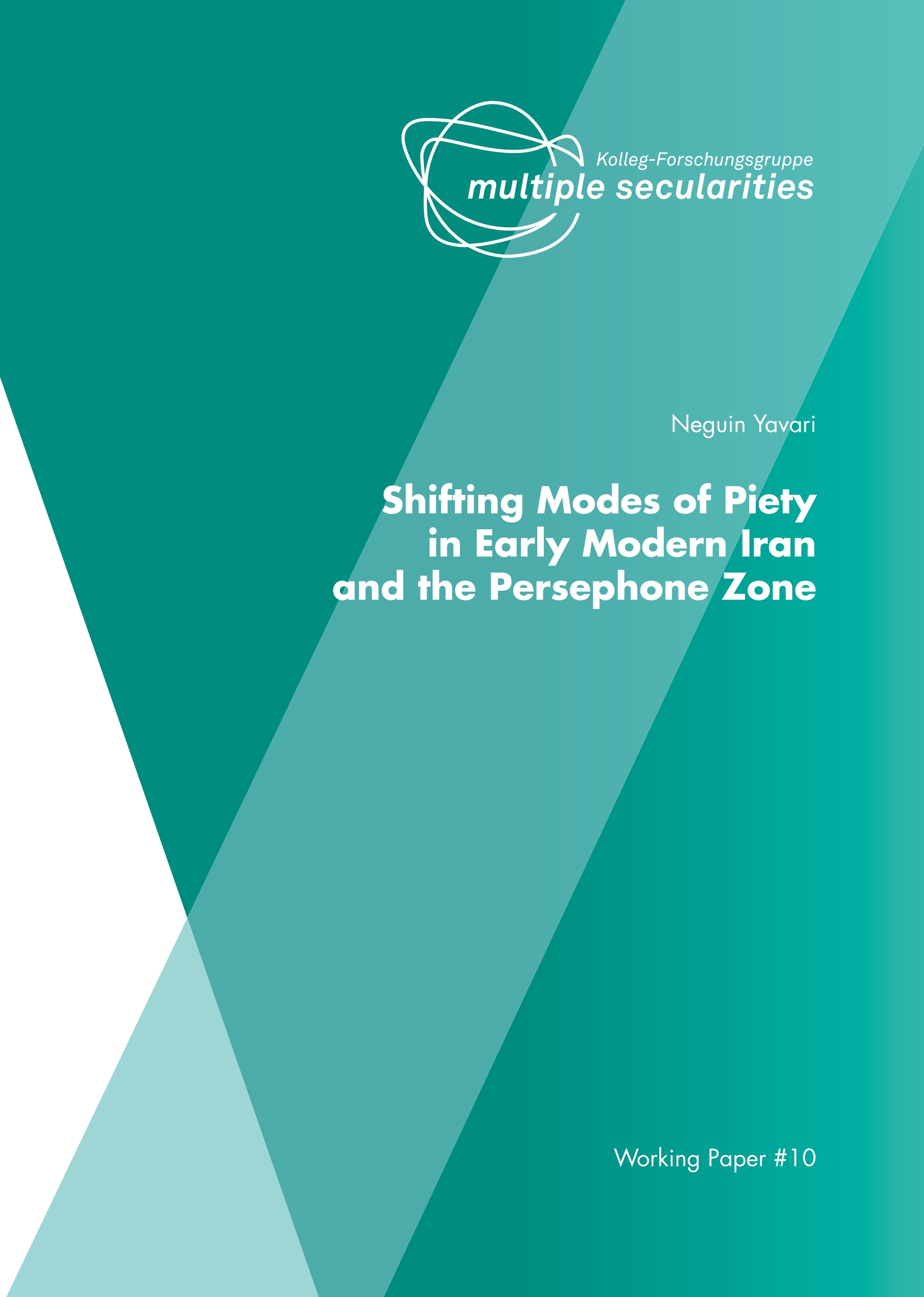 If any one thing marks early modern history, it is religious transformation. Confessional and pietist movements, both European firsts, are prominent examples of such catalysts for change. In large parts of the Islamic world in the fifteenth and sixteenth centuries, it was Sufi piety that carried the day. The historiographical record reveals strikingly new imaginaires and novel modes of connectivity to the past. The focus in this paper is on the manifold ways in which new forms of religiosity redefined the landscape of politics in the eastern Islamic world. It traces invocations of the past in Fakhr al-Dīn Kāshifī’s (d. 1532) "Rashaḥāt ‘ayn al-ḥayāt" ("Sprinklings from the Fountain of Life"), a sixteenth-century collected biography of Naqshbandī Sufi masters, to argue that the classificatory schema adopted by the author reveals a template of secularity that marks a significant departure from past manners of adherence.
If any one thing marks early modern history, it is religious transformation. Confessional and pietist movements, both European firsts, are prominent examples of such catalysts for change. In large parts of the Islamic world in the fifteenth and sixteenth centuries, it was Sufi piety that carried the day. The historiographical record reveals strikingly new imaginaires and novel modes of connectivity to the past. The focus in this paper is on the manifold ways in which new forms of religiosity redefined the landscape of politics in the eastern Islamic world. It traces invocations of the past in Fakhr al-Dīn Kāshifī’s (d. 1532) "Rashaḥāt ‘ayn al-ḥayāt" ("Sprinklings from the Fountain of Life"), a sixteenth-century collected biography of Naqshbandī Sufi masters, to argue that the classificatory schema adopted by the author reveals a template of secularity that marks a significant departure from past manners of adherence.
Download pdf 2019-07-17#9: How (Not) to Take ‘Secularity’ Beyond the Modern West: Reflections from Islamic Sociology
Florian Zemmin
 Debates about the usability of the concept of ‘secularity’ in academic
research are not merely theoretical. Standpoints are also politically informed
and arguments are sometimes emotionally charged. To some,
merely using the term ‘secularity’ seems to inflict violence upon certain
objects of research or even upon themselves. Others object to applying
the concept beyond a particular arrangement of secularity, lest that
defense-worthy arrangement be undermined. Taking a step back, however,
the actual hermeneutical problem and historical question still seems rather
clearly to be this: is it possible to uncouple the link between secularism
as a political regime and secularity as an analytical concept with broader
historical purchase?
In this paper, I argue that the basic approach of Multiple Secularities is
indeed the commendable way forward, but could be refined and improved,
also by learning from the valid points of its critical alternatives. Thus, this
paper aspires to shed light on two basic questions, namely, how to take
‘secularity’ beyond the modern West, and, as a logical prior, why take ‘secularity’
beyond the modern West in the first place?
Debates about the usability of the concept of ‘secularity’ in academic
research are not merely theoretical. Standpoints are also politically informed
and arguments are sometimes emotionally charged. To some,
merely using the term ‘secularity’ seems to inflict violence upon certain
objects of research or even upon themselves. Others object to applying
the concept beyond a particular arrangement of secularity, lest that
defense-worthy arrangement be undermined. Taking a step back, however,
the actual hermeneutical problem and historical question still seems rather
clearly to be this: is it possible to uncouple the link between secularism
as a political regime and secularity as an analytical concept with broader
historical purchase?
In this paper, I argue that the basic approach of Multiple Secularities is
indeed the commendable way forward, but could be refined and improved,
also by learning from the valid points of its critical alternatives. Thus, this
paper aspires to shed light on two basic questions, namely, how to take
‘secularity’ beyond the modern West, and, as a logical prior, why take ‘secularity’
beyond the modern West in the first place?
Download pdf 2019-03-18#8: "Be a civilized citizen!" Corporate social responsibility and the new Chinese secular
Thomas David DuBois
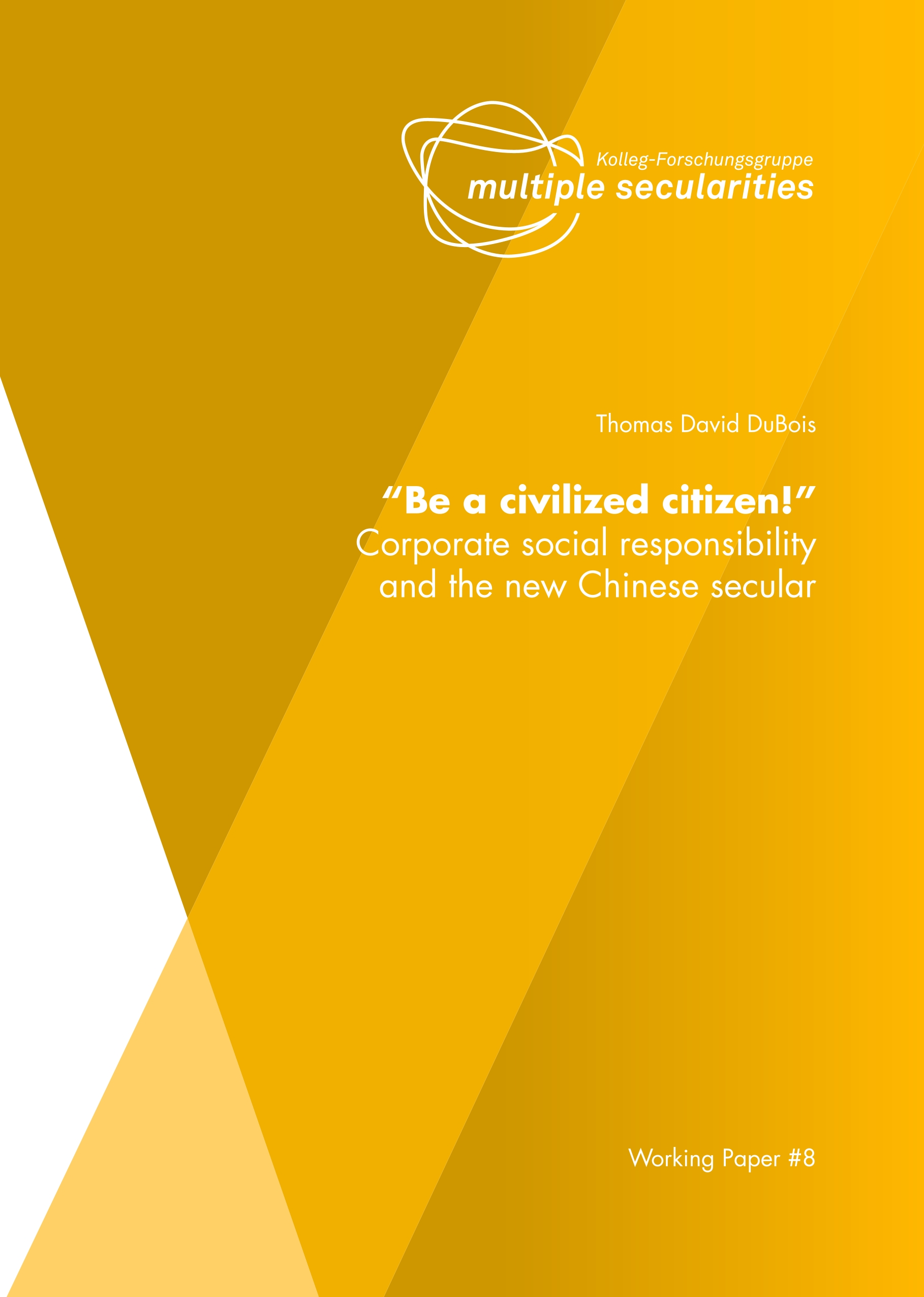 Disagreement over the nature of religion in China - a civilization that has long confounded the vocabulary of religious and secular - is nothing new. With an imperial institution that eclipsed confessional structures, and bound Heaven and Earth in ritual cosmology, China was what John Lagerwey called a “religious state.” When native notions of religion were forced into European-derived categories, the result was either a clash of interests, particularly with Christian missionaries, or dreadful mistranslations, such as the still pervasive idea of “emperor worship.” Religion in the twentieth century was been punctuated by periods of intense persecution, but the more longstanding policy of the People’s Republic has been to allow organized religion to exist, and even thrive, albeit at the cost of being coopted or transformed into a museum piece, its teaching is reduced to moral platitudes.
The ideological wave under Xi Jinping is something new. Combining nationalism, personal advancement, economic welfare, and an unprecedented level of surveillance of public and virtual spaces, this wave has made the state more ideologically pervasive than it has been in half a century. It has tamed the independent charitable organizations that grew up over the previous decade, but even this is just a symptom of the larger reorientation of ideology to public spaces to become what I call the “Chinese secular.”
Disagreement over the nature of religion in China - a civilization that has long confounded the vocabulary of religious and secular - is nothing new. With an imperial institution that eclipsed confessional structures, and bound Heaven and Earth in ritual cosmology, China was what John Lagerwey called a “religious state.” When native notions of religion were forced into European-derived categories, the result was either a clash of interests, particularly with Christian missionaries, or dreadful mistranslations, such as the still pervasive idea of “emperor worship.” Religion in the twentieth century was been punctuated by periods of intense persecution, but the more longstanding policy of the People’s Republic has been to allow organized religion to exist, and even thrive, albeit at the cost of being coopted or transformed into a museum piece, its teaching is reduced to moral platitudes.
The ideological wave under Xi Jinping is something new. Combining nationalism, personal advancement, economic welfare, and an unprecedented level of surveillance of public and virtual spaces, this wave has made the state more ideologically pervasive than it has been in half a century. It has tamed the independent charitable organizations that grew up over the previous decade, but even this is just a symptom of the larger reorientation of ideology to public spaces to become what I call the “Chinese secular.”
Download pdf 2019-02-21#7 Modes of Religionization: A Constructivist Approach to Secularity
Markus Dreßler
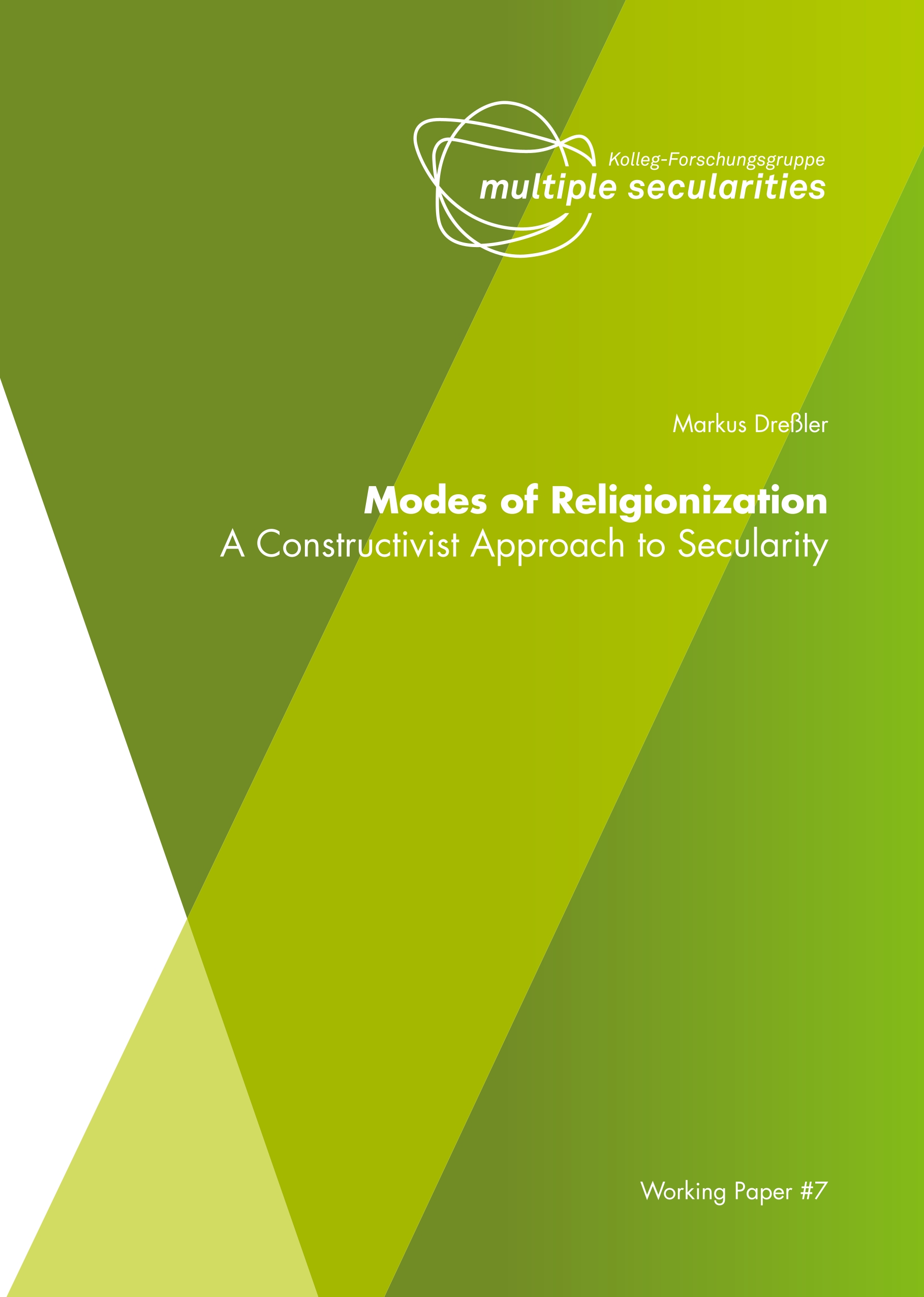 This article discusses four concepts: religionization, religio-secularization, religio-secularism, and religion-making. These concepts are proposed as heuristic devices for the analysis of the processes through which social networks, practices, and discourses come to be understood as ‘religious’ or ‘religion.’
I use the term ‘religionization’ to describe situations where assemblages of knowledge (structures, practices, discourses) are being made sense of through the modern concept of religion. I use ‘religio-secularization’ to illustrate the connection between religionization and secularization in the modern context. I use ‘religio-secularism’ to denote the knowledge regime that legitimizes processes of religionization and secularization. Finally, the term ‘religion-making’ is proposed as a means of focusing on agency in processes of religionization.
This article discusses four concepts: religionization, religio-secularization, religio-secularism, and religion-making. These concepts are proposed as heuristic devices for the analysis of the processes through which social networks, practices, and discourses come to be understood as ‘religious’ or ‘religion.’
I use the term ‘religionization’ to describe situations where assemblages of knowledge (structures, practices, discourses) are being made sense of through the modern concept of religion. I use ‘religio-secularization’ to illustrate the connection between religionization and secularization in the modern context. I use ‘religio-secularism’ to denote the knowledge regime that legitimizes processes of religionization and secularization. Finally, the term ‘religion-making’ is proposed as a means of focusing on agency in processes of religionization.
Download pdf 2019-02-14#6 Mistaken Anti-modernity: Fardid After Fardid
Ali Mirsepassi
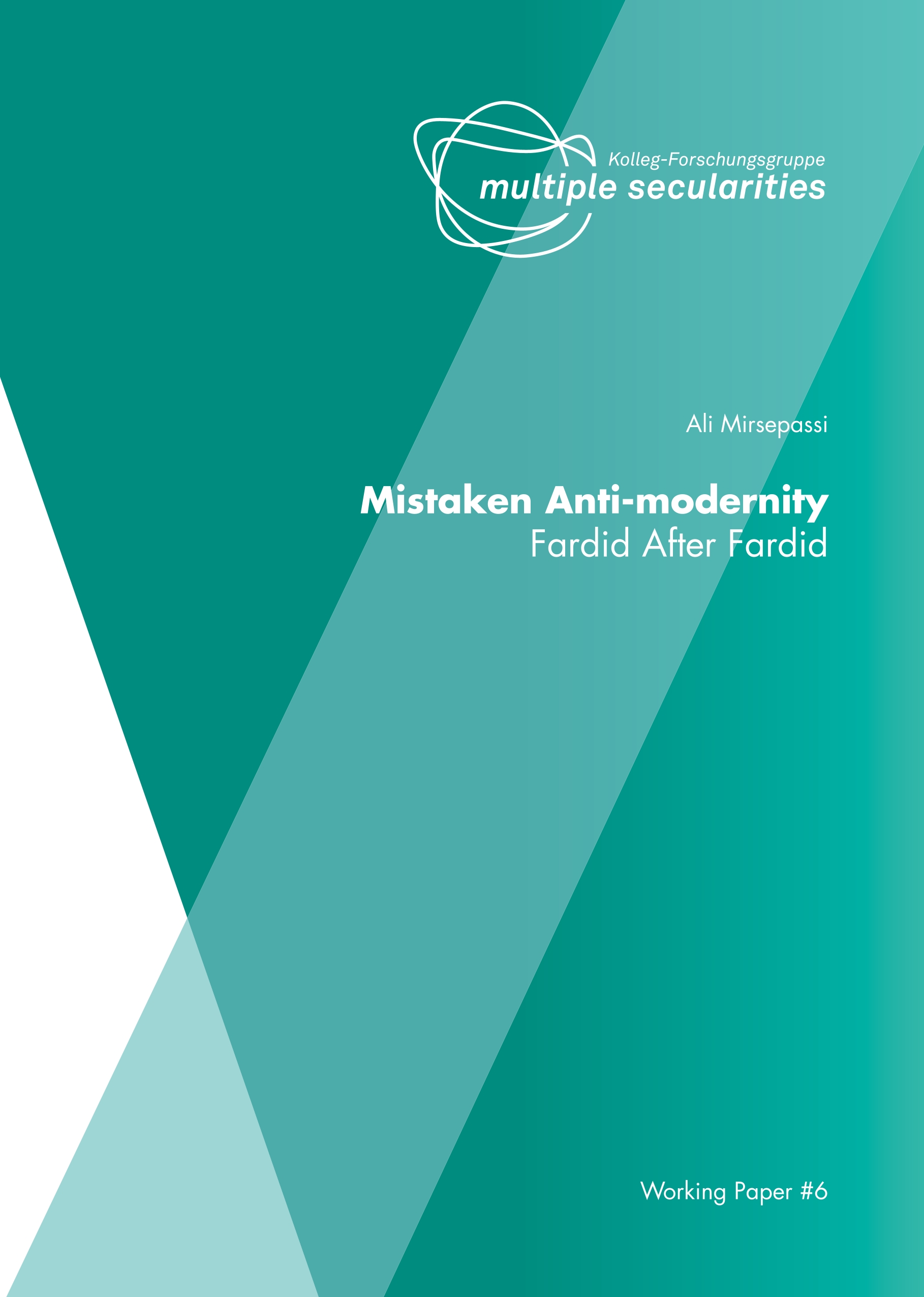 In this article, I undertake several lines of enquiry in the history of ideological and political movements centered on the “modernity” polemic at the transnational level. By analyzing these movements in juxtaposition, I explore the possibility of more diverse narratives of modernity and antimodernity than are assumed by conventional dichotomies in contemporary academic writings. The results of my enquiry challenge several pervasive “dogmas” of post-colonial theory: that orientalism is a purely modernist intellectual project, while anti-orientalism is by necessity its more “local” discursive counterpart in a dualism of East and West.
In this article, I undertake several lines of enquiry in the history of ideological and political movements centered on the “modernity” polemic at the transnational level. By analyzing these movements in juxtaposition, I explore the possibility of more diverse narratives of modernity and antimodernity than are assumed by conventional dichotomies in contemporary academic writings. The results of my enquiry challenge several pervasive “dogmas” of post-colonial theory: that orientalism is a purely modernist intellectual project, while anti-orientalism is by necessity its more “local” discursive counterpart in a dualism of East and West.
Download pdf 2018-07-10#5: The Secular Ground Bass of Pre-modern Japan Reconsidered. Reflections upon the Buddhist Trajectories towards Secularity
Christoph Kleine
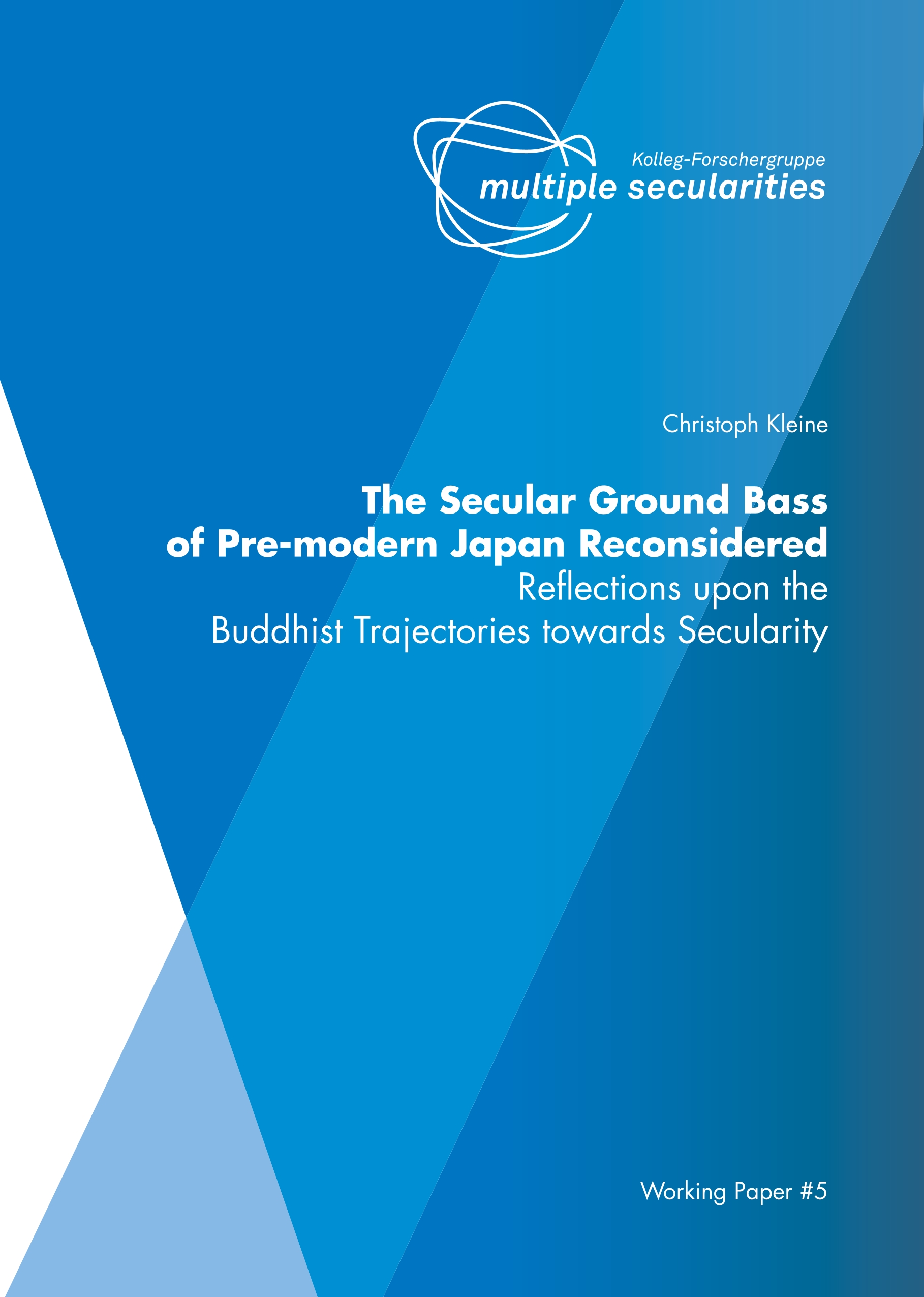 As can be easily recognised, the title of this paper alludes to a famous statement by Robert N. Bellah. In his article “Values and Social Change in Modern Japan,” originally published in 1970, Bellah identified “worldly affirmativeness, the opposite of denial” as “the ground bass […] of the Japanese tradition.” This may, at first sight, seem to be consistent with my rather provocative notion of the ‘secular ground bass of pre-modern Japan.’ Is “worldly affirmativeness”
not actually a key feature of ‘secularity,’ and of ‘modernity’ for that matter? However, Bellah’s argument runs in the very opposite direction. Contrary to what one might expect, worldly affirmativeness, in Bellah’s view, did not pave the way for secularity but, rather, prevented it. The reason is, says Bellah, that the alleged ground bass of worldly affirmativeness was responsible for the ‘failure’ of the early modern Japanese to actualise the moment of transcendence that had been recognised and strongly emphasised by medieval Buddhist thinkers already. I adopt a completely different approach. I aim to demonstrate that the medieval Japanese had already developed a set of epistemes with a longue durée, which turned out to be favourable for appropriating modern Western concepts of secularity in the 19th century, because they clearly distinguished between two social domains, which we – from a modern perspective – would label roughly as ‘religion’ on the one hand and ‘politics’ on the other. In other words, we find social structures and related systems of classification that come quite close to the ideal type of secularity as originally defined by Monika Wohlrab-Sahr and Marian Burchardt, namely: “institutionally as well as symbolically embedded forms and arrangements for distinguishing between religion and other societal areas, practices and interpretations.”
As can be easily recognised, the title of this paper alludes to a famous statement by Robert N. Bellah. In his article “Values and Social Change in Modern Japan,” originally published in 1970, Bellah identified “worldly affirmativeness, the opposite of denial” as “the ground bass […] of the Japanese tradition.” This may, at first sight, seem to be consistent with my rather provocative notion of the ‘secular ground bass of pre-modern Japan.’ Is “worldly affirmativeness”
not actually a key feature of ‘secularity,’ and of ‘modernity’ for that matter? However, Bellah’s argument runs in the very opposite direction. Contrary to what one might expect, worldly affirmativeness, in Bellah’s view, did not pave the way for secularity but, rather, prevented it. The reason is, says Bellah, that the alleged ground bass of worldly affirmativeness was responsible for the ‘failure’ of the early modern Japanese to actualise the moment of transcendence that had been recognised and strongly emphasised by medieval Buddhist thinkers already. I adopt a completely different approach. I aim to demonstrate that the medieval Japanese had already developed a set of epistemes with a longue durée, which turned out to be favourable for appropriating modern Western concepts of secularity in the 19th century, because they clearly distinguished between two social domains, which we – from a modern perspective – would label roughly as ‘religion’ on the one hand and ‘politics’ on the other. In other words, we find social structures and related systems of classification that come quite close to the ideal type of secularity as originally defined by Monika Wohlrab-Sahr and Marian Burchardt, namely: “institutionally as well as symbolically embedded forms and arrangements for distinguishing between religion and other societal areas, practices and interpretations.”
Download pdf 2018-04-03#4: Healing and/or Salvation? The Relationship Between Religion and Medicine in Medieval Chinese Buddhism
C. Pierce Salguero
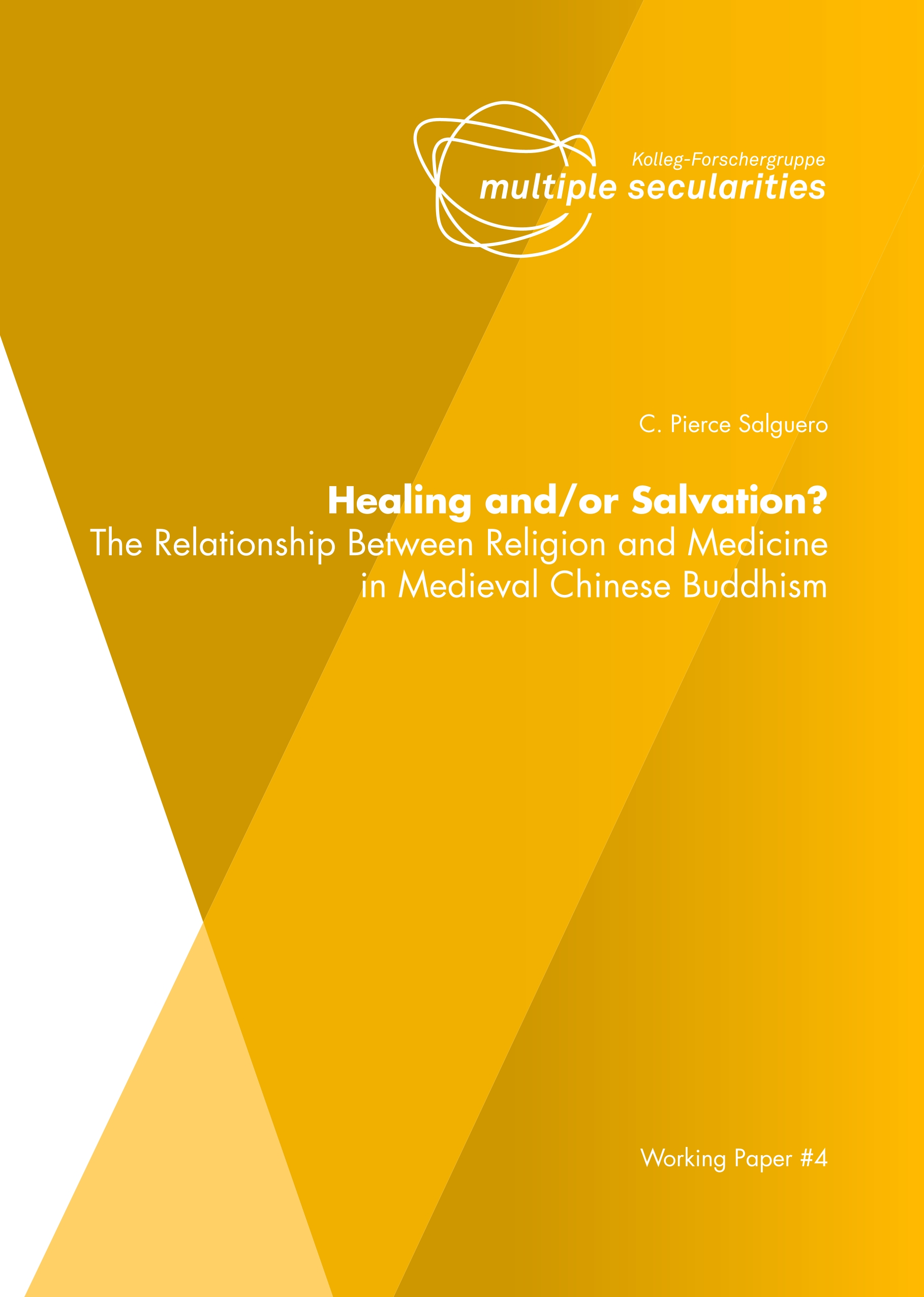 A wide variety of Buddhist writings originating on the Indian subcontinent and elsewhere in South and Southeast Asia were translated into Chinese between the mid-second and the early eleventh centuries C.E. As this material was read, digested, commented upon, and integrated into daily life, Chinese audiences came to be familiar with Buddhism’s basic teaching that overcoming all forms of suffering (Ch. ku 苦; Skt. duḥkha) is its core function. As one of the most obvious forms of suffering encountered in everyday human life, illness was a frequent topic of concern in these discourses. Of particular concern was the question of the relationship between the alleviation of the suffering of illness and the total, final salvation from suffering of all kinds (commonly referred to as Ch. niepan 涅槃; Skt. nirvāṇa; among other terms). This question appears and reappears across the genres of the Buddhist canon. From sūtras (loosely meaning “scriptures”), to disciplinary texts, ritual manuals, narratives, parables, philosophical treatises, and poetry, illness and healing are everywhere in Buddhist literature.
A wide variety of Buddhist writings originating on the Indian subcontinent and elsewhere in South and Southeast Asia were translated into Chinese between the mid-second and the early eleventh centuries C.E. As this material was read, digested, commented upon, and integrated into daily life, Chinese audiences came to be familiar with Buddhism’s basic teaching that overcoming all forms of suffering (Ch. ku 苦; Skt. duḥkha) is its core function. As one of the most obvious forms of suffering encountered in everyday human life, illness was a frequent topic of concern in these discourses. Of particular concern was the question of the relationship between the alleviation of the suffering of illness and the total, final salvation from suffering of all kinds (commonly referred to as Ch. niepan 涅槃; Skt. nirvāṇa; among other terms). This question appears and reappears across the genres of the Buddhist canon. From sūtras (loosely meaning “scriptures”), to disciplinary texts, ritual manuals, narratives, parables, philosophical treatises, and poetry, illness and healing are everywhere in Buddhist literature.
Download pdf 2018-03-22#3: The Islamicate Adab Tradition vs. the Islamic Shari‘a, from Pre-Colonial to Colonial
Armando Salvatore
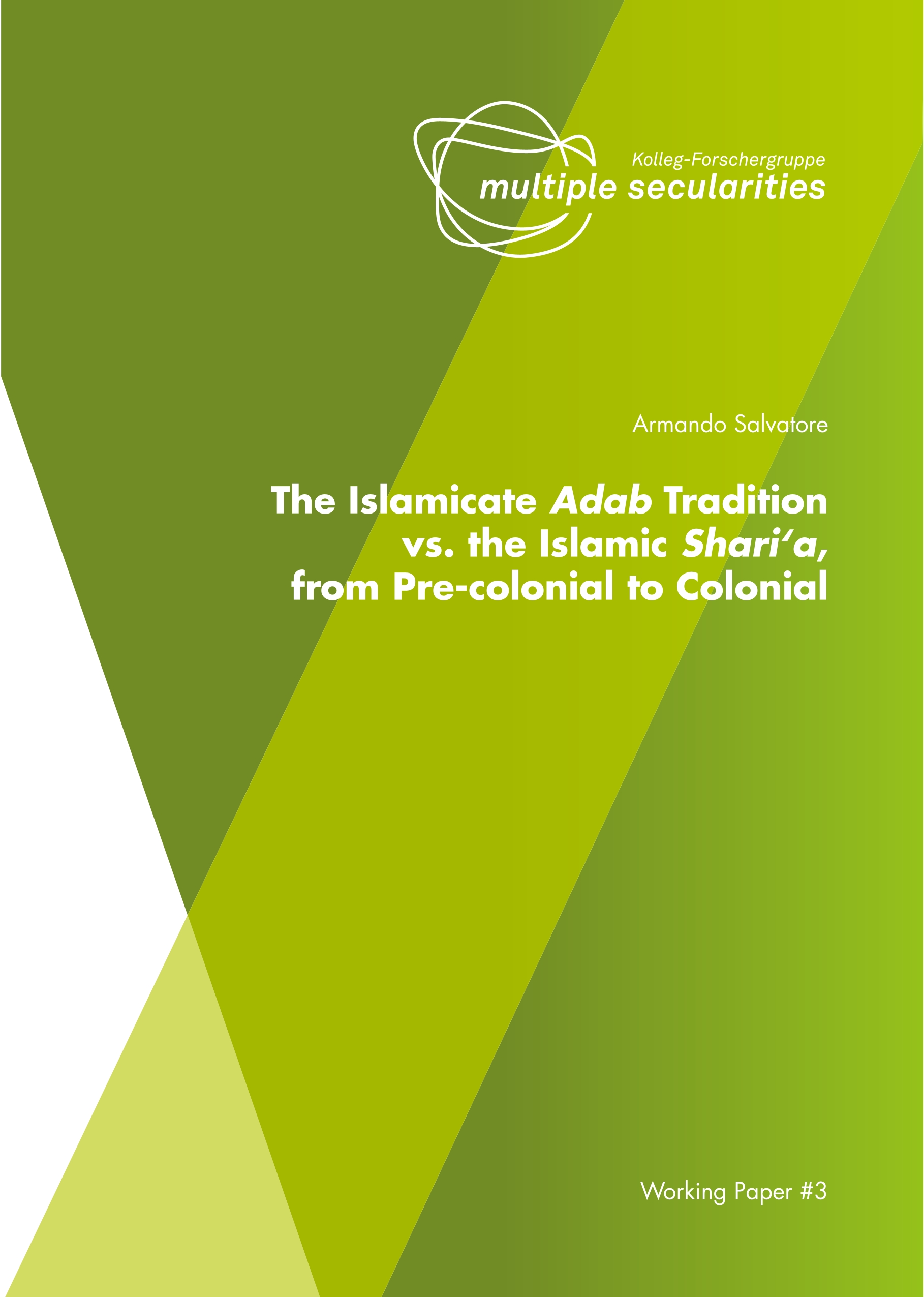 The goal of this paper is to provide a bird’s eye view on what might qualify as ‘the mother of all distinctions’ within Islamicate history affecting the regulation of human conduct. It is a rather ‘soft’ distinction, whereby the ethical and literary tradition of adab works as an harmonious counterpoint, more than as a sheer alternative, to the normative discourse subsumed under the notion of shari‘a, the law originating from Divine will (shar‘). Adab does so, however, while clearly affirming a distinctive, non-divine (and in this sense ‘secular’) source of norms of human interaction. The paper is divided into two parts: the first delineates the traits of adab in pre-colonial times, while the second focuses on key transformations it underwent during the colonial era.
The goal of this paper is to provide a bird’s eye view on what might qualify as ‘the mother of all distinctions’ within Islamicate history affecting the regulation of human conduct. It is a rather ‘soft’ distinction, whereby the ethical and literary tradition of adab works as an harmonious counterpoint, more than as a sheer alternative, to the normative discourse subsumed under the notion of shari‘a, the law originating from Divine will (shar‘). Adab does so, however, while clearly affirming a distinctive, non-divine (and in this sense ‘secular’) source of norms of human interaction. The paper is divided into two parts: the first delineates the traits of adab in pre-colonial times, while the second focuses on key transformations it underwent during the colonial era.
Download pdf


 Since the tenth century, the main religious force in Russia has been Orthodox Christianity. This branch of the Christian Church developed differently from its Western counterpart, Latin Christianity, after the geopolitical paths of the Western and Eastern Roman Empires diverged following the Migration Period in Late Antiquity. The different developments in the Christian East and West also led to distinct path dependencies, which informed the conceptualisation of the boundaries between the religious and the secular spheres. This working paper probes these differences, via an analysis of two important texts from early modern Russia: Feofan Prokopovich’s 1718 Palm Sunday sermon about “The Dignity and Power of the Sovereign,” and his 1721 “Spiritual Regulation.” By focusing on these two documents, whose conceptual foundations arguably shaped the structure of the Russian church for two centuries, the paper provides a first glimpse into the official discourse of religion and its discontents in early eighteenth-century Russia.
Since the tenth century, the main religious force in Russia has been Orthodox Christianity. This branch of the Christian Church developed differently from its Western counterpart, Latin Christianity, after the geopolitical paths of the Western and Eastern Roman Empires diverged following the Migration Period in Late Antiquity. The different developments in the Christian East and West also led to distinct path dependencies, which informed the conceptualisation of the boundaries between the religious and the secular spheres. This working paper probes these differences, via an analysis of two important texts from early modern Russia: Feofan Prokopovich’s 1718 Palm Sunday sermon about “The Dignity and Power of the Sovereign,” and his 1721 “Spiritual Regulation.” By focusing on these two documents, whose conceptual foundations arguably shaped the structure of the Russian church for two centuries, the paper provides a first glimpse into the official discourse of religion and its discontents in early eighteenth-century Russia. Recent political conflicts have highlighted the influence of religious actors and organisations in the public spheres of Latin American countries. The Pentecostal Evangelical movement in Colombia was crucial to the success of the ‘No’ campaign in the 2016 plebiscite, in which citizens rejected the peace agreement between the government and the Revolutionary Armed Forces of Colombia (FARC). In Brazil, evangelical congregations played a central role during the 2016 impeachment of President Dilma Rousseff, and in the subsequent rise of Jair Bolsonaro. In Bolivia, evangelical leaders and conservative elements of the Catholic Church alike supported the 2019 coup against Evo Morales. In Mexico, the 2018 rise of left-wing President Andrés Manuel López Obrador has been accompanied by criticism of his proximity to religious actors, and his moralising political rhetoric. Some authors have even described the Mexican leader as a politician with messianic overtones.
Against this background, it is worth asking what the implications of the recent convergence between politics and religion in Latin America are. To answer this question, we must avoid the oversimplification of suggesting a singular process of religious advance in Latin American societies. It is important to instead highlight the complex interaction of: 1) the process of secularisation (involving both secularism and secularity) in the region, 2) the trend towards pluralisation of the religious field, 3) the concurrence of counter-secular expressions in the public space, 4) and the occurrence of conflict in the political arena.
Although secularisation in Latin America historically emerged as a process of distinction of the political sphere, I argue here that it is currently expressed as a democratic ideal through the process of the dispersal in society of certain secular notions favouring state autonomy, especially in those countries that maintain the secularism legally established in the nineteenth century. My approach raises the question of how the boundaries between religion and the state in Mexico have been defined historically, and what the current status of this differentiation is. I also advance the analytical notion of sacred secularism, as a principle and expectation in the public space.
Recent political conflicts have highlighted the influence of religious actors and organisations in the public spheres of Latin American countries. The Pentecostal Evangelical movement in Colombia was crucial to the success of the ‘No’ campaign in the 2016 plebiscite, in which citizens rejected the peace agreement between the government and the Revolutionary Armed Forces of Colombia (FARC). In Brazil, evangelical congregations played a central role during the 2016 impeachment of President Dilma Rousseff, and in the subsequent rise of Jair Bolsonaro. In Bolivia, evangelical leaders and conservative elements of the Catholic Church alike supported the 2019 coup against Evo Morales. In Mexico, the 2018 rise of left-wing President Andrés Manuel López Obrador has been accompanied by criticism of his proximity to religious actors, and his moralising political rhetoric. Some authors have even described the Mexican leader as a politician with messianic overtones.
Against this background, it is worth asking what the implications of the recent convergence between politics and religion in Latin America are. To answer this question, we must avoid the oversimplification of suggesting a singular process of religious advance in Latin American societies. It is important to instead highlight the complex interaction of: 1) the process of secularisation (involving both secularism and secularity) in the region, 2) the trend towards pluralisation of the religious field, 3) the concurrence of counter-secular expressions in the public space, 4) and the occurrence of conflict in the political arena.
Although secularisation in Latin America historically emerged as a process of distinction of the political sphere, I argue here that it is currently expressed as a democratic ideal through the process of the dispersal in society of certain secular notions favouring state autonomy, especially in those countries that maintain the secularism legally established in the nineteenth century. My approach raises the question of how the boundaries between religion and the state in Mexico have been defined historically, and what the current status of this differentiation is. I also advance the analytical notion of sacred secularism, as a principle and expectation in the public space. Much has been written in the past few decades about populism that most scholars approaching the subject feel obliged to begin by justifying their writing of yet another text. In this paper, the situation is somewhat different: whilst our analytical gaze is cast upon populism (and fascism, as a precursor or closely related social phenomenon), this is only indirectly the case. Our primary focus is, instead, on the relationship that populism has with religion and secularity. Or, more precisely, the relationships of diverse populisms with different religiosities and various secularities. While the religious and the secular are mentioned in numerous studies about populism, these topics have rarely been adequately elaborated. Even when they are discussed, they are treated only in a marginal way. The purpose of this work is, therefore, to highlight the complex and multi-faceted way that populisms in Europe and Latin America have related to religion and religiosity. A second, parallel objective of this work is to reflect on the particular relationships populism establishes with different understandings of the secular, specifically within the political sphere, i.e. ‘political secularity.’ Following the differentiation paradigm, another term one might see used for this is ‘laicity’ (laïcité in French, laicidad in Spanish). I understand this to refer specifically to the secularisation of the state and the areas of society which come under its control.
Much has been written in the past few decades about populism that most scholars approaching the subject feel obliged to begin by justifying their writing of yet another text. In this paper, the situation is somewhat different: whilst our analytical gaze is cast upon populism (and fascism, as a precursor or closely related social phenomenon), this is only indirectly the case. Our primary focus is, instead, on the relationship that populism has with religion and secularity. Or, more precisely, the relationships of diverse populisms with different religiosities and various secularities. While the religious and the secular are mentioned in numerous studies about populism, these topics have rarely been adequately elaborated. Even when they are discussed, they are treated only in a marginal way. The purpose of this work is, therefore, to highlight the complex and multi-faceted way that populisms in Europe and Latin America have related to religion and religiosity. A second, parallel objective of this work is to reflect on the particular relationships populism establishes with different understandings of the secular, specifically within the political sphere, i.e. ‘political secularity.’ Following the differentiation paradigm, another term one might see used for this is ‘laicity’ (laïcité in French, laicidad in Spanish). I understand this to refer specifically to the secularisation of the state and the areas of society which come under its control. In the context of my involvement with the CASHSS Multiple Secularities – Beyond the West, Beyond Modernities’ research programme, I chose Ghazali’s autobiography, and in particular his “crisis of indecision,” as an example of a pre-modern negotiation of the boundaries of religion at the micro level. The research programme suggests employing the analytical concept of secularity to investigate both non-Western and pre-modern forms of secularity, in terms of conceptual distinctions and institutional differentiations between religious and non-religious social spheres. In this essay, I would like to propose a method of pursuing these goals from my own theoretical perspective. More specifically, I will argue that in Ghazali’s reflections on spiritual religiosity, theology, philosophy and science, we can discern the individual engagement of a prominent Muslim thinker with emerging communicative realms. In the Modern Systems Theory of Niklas Luhmann, these realms are taken to represent functionally differentiated subsystems of modern society.
In the context of my involvement with the CASHSS Multiple Secularities – Beyond the West, Beyond Modernities’ research programme, I chose Ghazali’s autobiography, and in particular his “crisis of indecision,” as an example of a pre-modern negotiation of the boundaries of religion at the micro level. The research programme suggests employing the analytical concept of secularity to investigate both non-Western and pre-modern forms of secularity, in terms of conceptual distinctions and institutional differentiations between religious and non-religious social spheres. In this essay, I would like to propose a method of pursuing these goals from my own theoretical perspective. More specifically, I will argue that in Ghazali’s reflections on spiritual religiosity, theology, philosophy and science, we can discern the individual engagement of a prominent Muslim thinker with emerging communicative realms. In the Modern Systems Theory of Niklas Luhmann, these realms are taken to represent functionally differentiated subsystems of modern society. The study of secularity in Iceland has so far largely been restricted to institutional differentiation, alongside legal aspects of the relationship between the state and the country’s national church. This paper approaches the formation of secularity in the country from a different angle. Adopting a research perspective shaped by both cultural history and sociology of culture, it investigates the role of the Icelandic sagas, and the medieval culture which spawned them, in the development of secularity in Iceland. Instead of looking at the processes through which Christian religion came to be separated from other spheres of society, it probes the discourses legitimising such a separation. It pays special attention to the reception and understanding of the sagas and the medieval culture which produced them, and further asks how they provided a background against which a secular culture could be imagined, both in the past and for the present.
The study of secularity in Iceland has so far largely been restricted to institutional differentiation, alongside legal aspects of the relationship between the state and the country’s national church. This paper approaches the formation of secularity in the country from a different angle. Adopting a research perspective shaped by both cultural history and sociology of culture, it investigates the role of the Icelandic sagas, and the medieval culture which spawned them, in the development of secularity in Iceland. Instead of looking at the processes through which Christian religion came to be separated from other spheres of society, it probes the discourses legitimising such a separation. It pays special attention to the reception and understanding of the sagas and the medieval culture which produced them, and further asks how they provided a background against which a secular culture could be imagined, both in the past and for the present.
 This paper explores the political thought during the 1920s of Lala Lajpat Rai (1865–1928), a prominent anti-colonial nationalist. It outlines the historical context under which a secular politics became vital for Rai, and elaborates the intricate internal texture of his complex, often fluid vision of secularism. The second half of the paper explores the theoretical implications of Rai’s dynamic position. It illustrates how Lajpat Rai simultaneously articulated both a Hindu communal politics and a vision of secularism. By so doing, this paper challenges the long-drawn strict dichotomy between Hindu politics or Hindu ‘communalism’ and Indian secularism. Yet, the paper also pushes back against revisionist scholarship which, in challenging assumptions of strict mutual exclusivity between Indian secularism and Hindu communalism, has tended to overlook and undermine meaningful distinctions that still exist between these categories. This paper insists on the need to retain and respect the analytical distinctions between the two categories, even while recognising that they do not always exist in relation to each other as a strict dichotomy. Unearthing a hitherto-hidden Indian secularism articulated by this ‘Hindu communal’ politician, the paper will briefly explore the ways in which Rai’s complex position overlaps with, and is distinct from, Western variants of secularism, India’s constitutional secularism, and the Gandhian-Nehruvian vision, the latter of which became hegemonic till the 1970s. The paper ends by, very briefly, comparing Lajpat Rai’s position with Hindutva nationalism – a major influence on the contemporary Hindu right – and by reflecting on the relationship between the Hindu right and secularism.
This paper explores the political thought during the 1920s of Lala Lajpat Rai (1865–1928), a prominent anti-colonial nationalist. It outlines the historical context under which a secular politics became vital for Rai, and elaborates the intricate internal texture of his complex, often fluid vision of secularism. The second half of the paper explores the theoretical implications of Rai’s dynamic position. It illustrates how Lajpat Rai simultaneously articulated both a Hindu communal politics and a vision of secularism. By so doing, this paper challenges the long-drawn strict dichotomy between Hindu politics or Hindu ‘communalism’ and Indian secularism. Yet, the paper also pushes back against revisionist scholarship which, in challenging assumptions of strict mutual exclusivity between Indian secularism and Hindu communalism, has tended to overlook and undermine meaningful distinctions that still exist between these categories. This paper insists on the need to retain and respect the analytical distinctions between the two categories, even while recognising that they do not always exist in relation to each other as a strict dichotomy. Unearthing a hitherto-hidden Indian secularism articulated by this ‘Hindu communal’ politician, the paper will briefly explore the ways in which Rai’s complex position overlaps with, and is distinct from, Western variants of secularism, India’s constitutional secularism, and the Gandhian-Nehruvian vision, the latter of which became hegemonic till the 1970s. The paper ends by, very briefly, comparing Lajpat Rai’s position with Hindutva nationalism – a major influence on the contemporary Hindu right – and by reflecting on the relationship between the Hindu right and secularism. Why jump into a sea, where everything is seemingly fleeting, floating, and fluid? There is not a single concept that offers solid ground to stand on: ‘religion’ is problematic, ‘culture’ elusive, ‘secularity’ contested, and ‘Islam’ one big question mark. ‘Identity’, to name that which looms so large in modern contexts, fares no better. Yet jump we must if we are to do more than critique conceptualisations that we consider flawed, and instead provide what is expected of academics: critical reflection that does justice to the subject at hand, while at the same time speaking to wider intellectual, moral, and political concerns. This paper contributes to the debate on multiple secularities by discussing conceptualisations of religion and culture and their relevance to articulations of secularity ‘in Islam’. Written from the perspective of historically grounded Islamic studies, with a focus on the period up to 1500, this paper nonetheless addresses current concerns, for while the secular and hints at secularity can be identified in pre-modern Muslim majority contexts, they only emerged as themes of theoretically informed debate in the modern period.
Why jump into a sea, where everything is seemingly fleeting, floating, and fluid? There is not a single concept that offers solid ground to stand on: ‘religion’ is problematic, ‘culture’ elusive, ‘secularity’ contested, and ‘Islam’ one big question mark. ‘Identity’, to name that which looms so large in modern contexts, fares no better. Yet jump we must if we are to do more than critique conceptualisations that we consider flawed, and instead provide what is expected of academics: critical reflection that does justice to the subject at hand, while at the same time speaking to wider intellectual, moral, and political concerns. This paper contributes to the debate on multiple secularities by discussing conceptualisations of religion and culture and their relevance to articulations of secularity ‘in Islam’. Written from the perspective of historically grounded Islamic studies, with a focus on the period up to 1500, this paper nonetheless addresses current concerns, for while the secular and hints at secularity can be identified in pre-modern Muslim majority contexts, they only emerged as themes of theoretically informed debate in the modern period. In its initial research project description, the Centre for Advanced Studies in Humanities and Social Sciences (CASHSS) took a position on the longstanding academic and public debates on secularism, secularisation, and secularity. In doing so, The CASHSS took up the concept of Multiple Secularities and developed it further. Based on the hypothesis that distinguishing and differentiating practices are not an exclusive sign of Western modernity, we decided to systematically explore regions beyond the ‘Western world’, and in doing so expand our research remit beyond that on which Taylor had focused. We focused on regions that have been culturally shaped by Islam (the MENA region, Indonesia, India), as well as on Asia, which necessarily involved some overlap. These regional contexts differed historically and still do so today in terms of their propensity for conflict over boundary demarcation and the way in which relationships are established between the religious and the non-religious. What they have in common is that the application of the term ‘religion’ to the respective socio-cultural traditions is highly controversial. Exploring these regions brought different religious traditions as well as experiences of the confrontation with the Western world into focus, suggesting the prospect of instructive comparisons.
In its initial research project description, the Centre for Advanced Studies in Humanities and Social Sciences (CASHSS) took a position on the longstanding academic and public debates on secularism, secularisation, and secularity. In doing so, The CASHSS took up the concept of Multiple Secularities and developed it further. Based on the hypothesis that distinguishing and differentiating practices are not an exclusive sign of Western modernity, we decided to systematically explore regions beyond the ‘Western world’, and in doing so expand our research remit beyond that on which Taylor had focused. We focused on regions that have been culturally shaped by Islam (the MENA region, Indonesia, India), as well as on Asia, which necessarily involved some overlap. These regional contexts differed historically and still do so today in terms of their propensity for conflict over boundary demarcation and the way in which relationships are established between the religious and the non-religious. What they have in common is that the application of the term ‘religion’ to the respective socio-cultural traditions is highly controversial. Exploring these regions brought different religious traditions as well as experiences of the confrontation with the Western world into focus, suggesting the prospect of instructive comparisons.
 For many bureaucrats, temples are nuisances, traffic obstructions, acts of landgrabbing, or means of political assertion that contribute to inter-religious tensions. By contrast, builders, trustees or worshippers defend temples as spaces of divine manifestation, as responding to religious needs and providing space for religious festivals and community activity. In this article, I use the case study of the establishment of a controversial goddess temple in Bhopal to shed light on a fundamental rift between two ideal-type approaches to the city – as a secular place and as religious territory.
For many bureaucrats, temples are nuisances, traffic obstructions, acts of landgrabbing, or means of political assertion that contribute to inter-religious tensions. By contrast, builders, trustees or worshippers defend temples as spaces of divine manifestation, as responding to religious needs and providing space for religious festivals and community activity. In this article, I use the case study of the establishment of a controversial goddess temple in Bhopal to shed light on a fundamental rift between two ideal-type approaches to the city – as a secular place and as religious territory. This working paper is part of a larger research project on emerging visualities and imaginaries of living together in plurality and on equal terms. Against the background of growing majoritarianism in India and the normalization of violence against religious minorities and marginalized communities, the search for new visual forms and aesthetic means to counter increasing divisiveness and conflict has acquired exceptional urgency. It is a search pursued by many and in multiple directions, occasionally even in
the realm of marketing and advertising which is the focus of this article. The larger project considers documentaries, fictional films and transmedia interventions in order to understand how different actors seek to create new visualities that are markedly different from earlier form(at)s used to visually mediate the normative project of political secularism for many decades, but nevertheless draw on the idea that secularity is a mode of living together and socially interacting in plural societies.
This working paper is part of a larger research project on emerging visualities and imaginaries of living together in plurality and on equal terms. Against the background of growing majoritarianism in India and the normalization of violence against religious minorities and marginalized communities, the search for new visual forms and aesthetic means to counter increasing divisiveness and conflict has acquired exceptional urgency. It is a search pursued by many and in multiple directions, occasionally even in
the realm of marketing and advertising which is the focus of this article. The larger project considers documentaries, fictional films and transmedia interventions in order to understand how different actors seek to create new visualities that are markedly different from earlier form(at)s used to visually mediate the normative project of political secularism for many decades, but nevertheless draw on the idea that secularity is a mode of living together and socially interacting in plural societies. This paper is part of broader research on social welfare, understood in its broadest sense as social security, education, and health care, which the state has taken over gradually from religions as it has established its authority and thereby the ontological and the teleological legitimacy of secularity as a pillar of modernity. The paper explores the Chinese Communist Party’s evolving attitude towards religious affairs and philanthropy.
This paper is part of broader research on social welfare, understood in its broadest sense as social security, education, and health care, which the state has taken over gradually from religions as it has established its authority and thereby the ontological and the teleological legitimacy of secularity as a pillar of modernity. The paper explores the Chinese Communist Party’s evolving attitude towards religious affairs and philanthropy. This paper will examine the transformation dynamics of social change in Kurdish Alevi communities, while mostly focusing on the increasing sociopolitical and religious role of talips. Until the end of the 20th century, the socio-religious structure of Kurdish Alevis was dominated by two hereditary social positions, much like a caste system: on the one hand, the members of the sacred lineages (ocaks), who embody the religious authority, and on the other hand, the talips who are subordinated to the sacred lineages. This socio-religious structure provided a framework for Kurdish Alevi socioreligious organisations.
This paper will examine the transformation dynamics of social change in Kurdish Alevi communities, while mostly focusing on the increasing sociopolitical and religious role of talips. Until the end of the 20th century, the socio-religious structure of Kurdish Alevis was dominated by two hereditary social positions, much like a caste system: on the one hand, the members of the sacred lineages (ocaks), who embody the religious authority, and on the other hand, the talips who are subordinated to the sacred lineages. This socio-religious structure provided a framework for Kurdish Alevi socioreligious organisations. In this paper, we show how this plural legal landscape is negotiated by litigants, especially women, and thereby illustrate the procedural interplay between civil and religious courts through this adjudication process. The ethnography of adjudication at the Darul-Qaza situated in a large Muslim neighbourhood in Kanpur and the institution’s intersections with the societal (We mean the tribunals that function at the neighbourhood or community level) secular courts show how Muslim personal law functions. In this paper, we identify both the links between the Darul-Qaza and civil courts, and the processes of evidence making and legal reasoning that are integral to this interlegality. We argue that the issue of personal law should be understood within the post-colonial legal structure of India and with a good understanding of the processes through which disputes in the delicate area of family, affect and kinship are addressed and resolved. The above case shows how resolution occurs in a family dispute when plural institutional mechanisms are at work. This paper explores the adjudication process at a Darul-Qaza to understand how religion-based family laws get constituted as litigants seek both religious counsel and civil authority.
In this paper, we show how this plural legal landscape is negotiated by litigants, especially women, and thereby illustrate the procedural interplay between civil and religious courts through this adjudication process. The ethnography of adjudication at the Darul-Qaza situated in a large Muslim neighbourhood in Kanpur and the institution’s intersections with the societal (We mean the tribunals that function at the neighbourhood or community level) secular courts show how Muslim personal law functions. In this paper, we identify both the links between the Darul-Qaza and civil courts, and the processes of evidence making and legal reasoning that are integral to this interlegality. We argue that the issue of personal law should be understood within the post-colonial legal structure of India and with a good understanding of the processes through which disputes in the delicate area of family, affect and kinship are addressed and resolved. The above case shows how resolution occurs in a family dispute when plural institutional mechanisms are at work. This paper explores the adjudication process at a Darul-Qaza to understand how religion-based family laws get constituted as litigants seek both religious counsel and civil authority. This Working Paper is intended to suggest a fairly simple contention concerning a number of interconnected propositions made in connection with the debates on modernity and secularism. None of these propositions is particularly novel, nor is this the first time that they have been put forward. The simple contention I wish to start with concerns Islamism, often brought out emblematically when secularism and modernity are discussed. Like other self-consciously retrogressive identitarian motifs, ideas, sensibilities, moods and inflections of politics that sustain differentialist culturalism and are sustained by it conceptually, Islamism has come to gain very considerable political and social traction over the past quarter of a century. This had until recently reached the extent that it, as a perceptual grid of social and cultural purchase relating to societies and countries that many associate with Islam, has become hegemonic in public discussions about society and politics and, until recently, hegemonic without serious challenge. It has also been crucial for triggering the latest round of antisecular discussions and polemics.
This Working Paper is intended to suggest a fairly simple contention concerning a number of interconnected propositions made in connection with the debates on modernity and secularism. None of these propositions is particularly novel, nor is this the first time that they have been put forward. The simple contention I wish to start with concerns Islamism, often brought out emblematically when secularism and modernity are discussed. Like other self-consciously retrogressive identitarian motifs, ideas, sensibilities, moods and inflections of politics that sustain differentialist culturalism and are sustained by it conceptually, Islamism has come to gain very considerable political and social traction over the past quarter of a century. This had until recently reached the extent that it, as a perceptual grid of social and cultural purchase relating to societies and countries that many associate with Islam, has become hegemonic in public discussions about society and politics and, until recently, hegemonic without serious challenge. It has also been crucial for triggering the latest round of antisecular discussions and polemics. Iran’s constitutional revolution of 1906 is arguably the most significant turn toward the secular in its modern history. I start this investigation by making a conceptual distinction between secularism and secularity. Here, secularism is defined as the ideologically-driven separation of religion and state according to an agenda, a blueprint, a model, that could be indigenously, or externally informed and is achieved with the assistance of the modern state and explicit political motivations. Secularity, on the other hand, is expressed in terms of a non-ideological separation that comes about unintentionally. In some accounts, this separation may take on evolutionary connotations in terms of the natural separation of functions as a result of the growing complexity of a natural organism or social system. What I have in mind here is a separation of functions that is agent-driven but the secularity that emerges is both unintentional and unideological. In other words, separation is attained not because actors consciously distinguish between the religious and the political at the conceptual level, or experience a wholesale shift in belief systems, but because some new contexts open novel avenues for pursuing goals or interests that are experienced by actors as more effective than previously undifferentiated ones, without necessarily effecting conscious change, or any change, in belief systems.
Iran’s constitutional revolution of 1906 is arguably the most significant turn toward the secular in its modern history. I start this investigation by making a conceptual distinction between secularism and secularity. Here, secularism is defined as the ideologically-driven separation of religion and state according to an agenda, a blueprint, a model, that could be indigenously, or externally informed and is achieved with the assistance of the modern state and explicit political motivations. Secularity, on the other hand, is expressed in terms of a non-ideological separation that comes about unintentionally. In some accounts, this separation may take on evolutionary connotations in terms of the natural separation of functions as a result of the growing complexity of a natural organism or social system. What I have in mind here is a separation of functions that is agent-driven but the secularity that emerges is both unintentional and unideological. In other words, separation is attained not because actors consciously distinguish between the religious and the political at the conceptual level, or experience a wholesale shift in belief systems, but because some new contexts open novel avenues for pursuing goals or interests that are experienced by actors as more effective than previously undifferentiated ones, without necessarily effecting conscious change, or any change, in belief systems. This working paper aims to analyse the relationship between state and religion (in this case, Islam) in political and legal developments in Indonesia from colonial times to the present, and to determine the model of Indonesian secularity within the multiple secularities approach. The legal and political developments relating to the relationship between the state and Islam in Indonesia are understood to be the products of societal debate as well as instruments for solving particular societal problems, guided by certain guiding ideas that shape Indonesian secularity.
This working paper aims to analyse the relationship between state and religion (in this case, Islam) in political and legal developments in Indonesia from colonial times to the present, and to determine the model of Indonesian secularity within the multiple secularities approach. The legal and political developments relating to the relationship between the state and Islam in Indonesia are understood to be the products of societal debate as well as instruments for solving particular societal problems, guided by certain guiding ideas that shape Indonesian secularity. In the first half of the seventeenth century, three major Buddhist governments that combined a twofold religious and political structure under a Buddhist ruler were established in the Tibetan cultural area (Joint Twofold System of Governance). In 1625/26, Bhutan was united under the rule of a charismatic Tibetan Buddhist master, Tibet and Sikkim followed, both in 1642 – although with significant differences in their respective institutionalisation. The Working Paper presents findings of the specific and unique case example of pre-modern Bhutan to yield benefit for further interdisciplinary discourses about secularity, religion, and modernity in contemporary Bhutan – paying thereby tribute to the complexity of this field of research. Besides for Bhutan, this analytical framework can be adapted for further research about different pre-modern formations of the Joint Twofold System of Governance in the Tibetan cultural area as a whole.
In the first half of the seventeenth century, three major Buddhist governments that combined a twofold religious and political structure under a Buddhist ruler were established in the Tibetan cultural area (Joint Twofold System of Governance). In 1625/26, Bhutan was united under the rule of a charismatic Tibetan Buddhist master, Tibet and Sikkim followed, both in 1642 – although with significant differences in their respective institutionalisation. The Working Paper presents findings of the specific and unique case example of pre-modern Bhutan to yield benefit for further interdisciplinary discourses about secularity, religion, and modernity in contemporary Bhutan – paying thereby tribute to the complexity of this field of research. Besides for Bhutan, this analytical framework can be adapted for further research about different pre-modern formations of the Joint Twofold System of Governance in the Tibetan cultural area as a whole. This working paper explores what I consider to be a tenuous but persistent form of “public culture” extending between Inner Asia and Europe over the course of the eighteenth and, especially, nineteenth centuries. This “stranger relationality,” as Michael Warner would have it, was mediated by new forms and routes of Eurasianist textual circulation. In this late imperial period, spread along the frontiers of the Qing, Tsarist, and British empires, Tibetan, Mongolian, and Buryat monks read works by European and East Asian intellectuals on all manner of technical knowledge, and began writing not to fellow scholastics or local readers, but to a global community of “the knowledgeable” (Tib. mkhas pa; Mon. baγsi, nomčin).
This paper introduces the social sites of my sources, the Buddhist monastic colleges that spanned the Sino-Russian frontiers, and provides a few examples of synthetic scholastic products that emerged in this previously unstudied form of Eurasianist public culture (c. 1750–1930s). I will also share some preliminary arguments about the ways that practices of secularity amongst the actors led directly to the creation of the modern public sphere, civil society, and ironically, revolutionary institutional forms and models of history that had violently erased scholastic culture from public life.
This working paper explores what I consider to be a tenuous but persistent form of “public culture” extending between Inner Asia and Europe over the course of the eighteenth and, especially, nineteenth centuries. This “stranger relationality,” as Michael Warner would have it, was mediated by new forms and routes of Eurasianist textual circulation. In this late imperial period, spread along the frontiers of the Qing, Tsarist, and British empires, Tibetan, Mongolian, and Buryat monks read works by European and East Asian intellectuals on all manner of technical knowledge, and began writing not to fellow scholastics or local readers, but to a global community of “the knowledgeable” (Tib. mkhas pa; Mon. baγsi, nomčin).
This paper introduces the social sites of my sources, the Buddhist monastic colleges that spanned the Sino-Russian frontiers, and provides a few examples of synthetic scholastic products that emerged in this previously unstudied form of Eurasianist public culture (c. 1750–1930s). I will also share some preliminary arguments about the ways that practices of secularity amongst the actors led directly to the creation of the modern public sphere, civil society, and ironically, revolutionary institutional forms and models of history that had violently erased scholastic culture from public life. If any one thing marks early modern history, it is religious transformation. Confessional and pietist movements, both European firsts, are prominent examples of such catalysts for change. In large parts of the Islamic world in the fifteenth and sixteenth centuries, it was Sufi piety that carried the day. The historiographical record reveals strikingly new imaginaires and novel modes of connectivity to the past. The focus in this paper is on the manifold ways in which new forms of religiosity redefined the landscape of politics in the eastern Islamic world. It traces invocations of the past in Fakhr al-Dīn Kāshifī’s (d. 1532) "Rashaḥāt ‘ayn al-ḥayāt" ("Sprinklings from the Fountain of Life"), a sixteenth-century collected biography of Naqshbandī Sufi masters, to argue that the classificatory schema adopted by the author reveals a template of secularity that marks a significant departure from past manners of adherence.
If any one thing marks early modern history, it is religious transformation. Confessional and pietist movements, both European firsts, are prominent examples of such catalysts for change. In large parts of the Islamic world in the fifteenth and sixteenth centuries, it was Sufi piety that carried the day. The historiographical record reveals strikingly new imaginaires and novel modes of connectivity to the past. The focus in this paper is on the manifold ways in which new forms of religiosity redefined the landscape of politics in the eastern Islamic world. It traces invocations of the past in Fakhr al-Dīn Kāshifī’s (d. 1532) "Rashaḥāt ‘ayn al-ḥayāt" ("Sprinklings from the Fountain of Life"), a sixteenth-century collected biography of Naqshbandī Sufi masters, to argue that the classificatory schema adopted by the author reveals a template of secularity that marks a significant departure from past manners of adherence. Debates about the usability of the concept of ‘secularity’ in academic
research are not merely theoretical. Standpoints are also politically informed
and arguments are sometimes emotionally charged. To some,
merely using the term ‘secularity’ seems to inflict violence upon certain
objects of research or even upon themselves. Others object to applying
the concept beyond a particular arrangement of secularity, lest that
defense-worthy arrangement be undermined. Taking a step back, however,
the actual hermeneutical problem and historical question still seems rather
clearly to be this: is it possible to uncouple the link between secularism
as a political regime and secularity as an analytical concept with broader
historical purchase?
In this paper, I argue that the basic approach of Multiple Secularities is
indeed the commendable way forward, but could be refined and improved,
also by learning from the valid points of its critical alternatives. Thus, this
paper aspires to shed light on two basic questions, namely, how to take
‘secularity’ beyond the modern West, and, as a logical prior, why take ‘secularity’
beyond the modern West in the first place?
Debates about the usability of the concept of ‘secularity’ in academic
research are not merely theoretical. Standpoints are also politically informed
and arguments are sometimes emotionally charged. To some,
merely using the term ‘secularity’ seems to inflict violence upon certain
objects of research or even upon themselves. Others object to applying
the concept beyond a particular arrangement of secularity, lest that
defense-worthy arrangement be undermined. Taking a step back, however,
the actual hermeneutical problem and historical question still seems rather
clearly to be this: is it possible to uncouple the link between secularism
as a political regime and secularity as an analytical concept with broader
historical purchase?
In this paper, I argue that the basic approach of Multiple Secularities is
indeed the commendable way forward, but could be refined and improved,
also by learning from the valid points of its critical alternatives. Thus, this
paper aspires to shed light on two basic questions, namely, how to take
‘secularity’ beyond the modern West, and, as a logical prior, why take ‘secularity’
beyond the modern West in the first place? Disagreement over the nature of religion in China - a civilization that has long confounded the vocabulary of religious and secular - is nothing new. With an imperial institution that eclipsed confessional structures, and bound Heaven and Earth in ritual cosmology, China was what John Lagerwey called a “religious state.” When native notions of religion were forced into European-derived categories, the result was either a clash of interests, particularly with Christian missionaries, or dreadful mistranslations, such as the still pervasive idea of “emperor worship.” Religion in the twentieth century was been punctuated by periods of intense persecution, but the more longstanding policy of the People’s Republic has been to allow organized religion to exist, and even thrive, albeit at the cost of being coopted or transformed into a museum piece, its teaching is reduced to moral platitudes.
The ideological wave under Xi Jinping is something new. Combining nationalism, personal advancement, economic welfare, and an unprecedented level of surveillance of public and virtual spaces, this wave has made the state more ideologically pervasive than it has been in half a century. It has tamed the independent charitable organizations that grew up over the previous decade, but even this is just a symptom of the larger reorientation of ideology to public spaces to become what I call the “Chinese secular.”
Disagreement over the nature of religion in China - a civilization that has long confounded the vocabulary of religious and secular - is nothing new. With an imperial institution that eclipsed confessional structures, and bound Heaven and Earth in ritual cosmology, China was what John Lagerwey called a “religious state.” When native notions of religion were forced into European-derived categories, the result was either a clash of interests, particularly with Christian missionaries, or dreadful mistranslations, such as the still pervasive idea of “emperor worship.” Religion in the twentieth century was been punctuated by periods of intense persecution, but the more longstanding policy of the People’s Republic has been to allow organized religion to exist, and even thrive, albeit at the cost of being coopted or transformed into a museum piece, its teaching is reduced to moral platitudes.
The ideological wave under Xi Jinping is something new. Combining nationalism, personal advancement, economic welfare, and an unprecedented level of surveillance of public and virtual spaces, this wave has made the state more ideologically pervasive than it has been in half a century. It has tamed the independent charitable organizations that grew up over the previous decade, but even this is just a symptom of the larger reorientation of ideology to public spaces to become what I call the “Chinese secular.” This article discusses four concepts: religionization, religio-secularization, religio-secularism, and religion-making. These concepts are proposed as heuristic devices for the analysis of the processes through which social networks, practices, and discourses come to be understood as ‘religious’ or ‘religion.’
I use the term ‘religionization’ to describe situations where assemblages of knowledge (structures, practices, discourses) are being made sense of through the modern concept of religion. I use ‘religio-secularization’ to illustrate the connection between religionization and secularization in the modern context. I use ‘religio-secularism’ to denote the knowledge regime that legitimizes processes of religionization and secularization. Finally, the term ‘religion-making’ is proposed as a means of focusing on agency in processes of religionization.
This article discusses four concepts: religionization, religio-secularization, religio-secularism, and religion-making. These concepts are proposed as heuristic devices for the analysis of the processes through which social networks, practices, and discourses come to be understood as ‘religious’ or ‘religion.’
I use the term ‘religionization’ to describe situations where assemblages of knowledge (structures, practices, discourses) are being made sense of through the modern concept of religion. I use ‘religio-secularization’ to illustrate the connection between religionization and secularization in the modern context. I use ‘religio-secularism’ to denote the knowledge regime that legitimizes processes of religionization and secularization. Finally, the term ‘religion-making’ is proposed as a means of focusing on agency in processes of religionization. In this article, I undertake several lines of enquiry in the history of ideological and political movements centered on the “modernity” polemic at the transnational level. By analyzing these movements in juxtaposition, I explore the possibility of more diverse narratives of modernity and antimodernity than are assumed by conventional dichotomies in contemporary academic writings. The results of my enquiry challenge several pervasive “dogmas” of post-colonial theory: that orientalism is a purely modernist intellectual project, while anti-orientalism is by necessity its more “local” discursive counterpart in a dualism of East and West.
In this article, I undertake several lines of enquiry in the history of ideological and political movements centered on the “modernity” polemic at the transnational level. By analyzing these movements in juxtaposition, I explore the possibility of more diverse narratives of modernity and antimodernity than are assumed by conventional dichotomies in contemporary academic writings. The results of my enquiry challenge several pervasive “dogmas” of post-colonial theory: that orientalism is a purely modernist intellectual project, while anti-orientalism is by necessity its more “local” discursive counterpart in a dualism of East and West. As can be easily recognised, the title of this paper alludes to a famous statement by Robert N. Bellah. In his article “Values and Social Change in Modern Japan,” originally published in 1970, Bellah identified “worldly affirmativeness, the opposite of denial” as “the ground bass […] of the Japanese tradition.” This may, at first sight, seem to be consistent with my rather provocative notion of the ‘secular ground bass of pre-modern Japan.’ Is “worldly affirmativeness”
not actually a key feature of ‘secularity,’ and of ‘modernity’ for that matter? However, Bellah’s argument runs in the very opposite direction. Contrary to what one might expect, worldly affirmativeness, in Bellah’s view, did not pave the way for secularity but, rather, prevented it. The reason is, says Bellah, that the alleged ground bass of worldly affirmativeness was responsible for the ‘failure’ of the early modern Japanese to actualise the moment of transcendence that had been recognised and strongly emphasised by medieval Buddhist thinkers already. I adopt a completely different approach. I aim to demonstrate that the medieval Japanese had already developed a set of epistemes with a longue durée, which turned out to be favourable for appropriating modern Western concepts of secularity in the 19th century, because they clearly distinguished between two social domains, which we – from a modern perspective – would label roughly as ‘religion’ on the one hand and ‘politics’ on the other. In other words, we find social structures and related systems of classification that come quite close to the ideal type of secularity as originally defined by Monika Wohlrab-Sahr and Marian Burchardt, namely: “institutionally as well as symbolically embedded forms and arrangements for distinguishing between religion and other societal areas, practices and interpretations.”
As can be easily recognised, the title of this paper alludes to a famous statement by Robert N. Bellah. In his article “Values and Social Change in Modern Japan,” originally published in 1970, Bellah identified “worldly affirmativeness, the opposite of denial” as “the ground bass […] of the Japanese tradition.” This may, at first sight, seem to be consistent with my rather provocative notion of the ‘secular ground bass of pre-modern Japan.’ Is “worldly affirmativeness”
not actually a key feature of ‘secularity,’ and of ‘modernity’ for that matter? However, Bellah’s argument runs in the very opposite direction. Contrary to what one might expect, worldly affirmativeness, in Bellah’s view, did not pave the way for secularity but, rather, prevented it. The reason is, says Bellah, that the alleged ground bass of worldly affirmativeness was responsible for the ‘failure’ of the early modern Japanese to actualise the moment of transcendence that had been recognised and strongly emphasised by medieval Buddhist thinkers already. I adopt a completely different approach. I aim to demonstrate that the medieval Japanese had already developed a set of epistemes with a longue durée, which turned out to be favourable for appropriating modern Western concepts of secularity in the 19th century, because they clearly distinguished between two social domains, which we – from a modern perspective – would label roughly as ‘religion’ on the one hand and ‘politics’ on the other. In other words, we find social structures and related systems of classification that come quite close to the ideal type of secularity as originally defined by Monika Wohlrab-Sahr and Marian Burchardt, namely: “institutionally as well as symbolically embedded forms and arrangements for distinguishing between religion and other societal areas, practices and interpretations.” A wide variety of Buddhist writings originating on the Indian subcontinent and elsewhere in South and Southeast Asia were translated into Chinese between the mid-second and the early eleventh centuries C.E. As this material was read, digested, commented upon, and integrated into daily life, Chinese audiences came to be familiar with Buddhism’s basic teaching that overcoming all forms of suffering (Ch. ku 苦; Skt. duḥkha) is its core function. As one of the most obvious forms of suffering encountered in everyday human life, illness was a frequent topic of concern in these discourses. Of particular concern was the question of the relationship between the alleviation of the suffering of illness and the total, final salvation from suffering of all kinds (commonly referred to as Ch. niepan 涅槃; Skt. nirvāṇa; among other terms). This question appears and reappears across the genres of the Buddhist canon. From sūtras (loosely meaning “scriptures”), to disciplinary texts, ritual manuals, narratives, parables, philosophical treatises, and poetry, illness and healing are everywhere in Buddhist literature.
A wide variety of Buddhist writings originating on the Indian subcontinent and elsewhere in South and Southeast Asia were translated into Chinese between the mid-second and the early eleventh centuries C.E. As this material was read, digested, commented upon, and integrated into daily life, Chinese audiences came to be familiar with Buddhism’s basic teaching that overcoming all forms of suffering (Ch. ku 苦; Skt. duḥkha) is its core function. As one of the most obvious forms of suffering encountered in everyday human life, illness was a frequent topic of concern in these discourses. Of particular concern was the question of the relationship between the alleviation of the suffering of illness and the total, final salvation from suffering of all kinds (commonly referred to as Ch. niepan 涅槃; Skt. nirvāṇa; among other terms). This question appears and reappears across the genres of the Buddhist canon. From sūtras (loosely meaning “scriptures”), to disciplinary texts, ritual manuals, narratives, parables, philosophical treatises, and poetry, illness and healing are everywhere in Buddhist literature. The goal of this paper is to provide a bird’s eye view on what might qualify as ‘the mother of all distinctions’ within Islamicate history affecting the regulation of human conduct. It is a rather ‘soft’ distinction, whereby the ethical and literary tradition of adab works as an harmonious counterpoint, more than as a sheer alternative, to the normative discourse subsumed under the notion of shari‘a, the law originating from Divine will (shar‘). Adab does so, however, while clearly affirming a distinctive, non-divine (and in this sense ‘secular’) source of norms of human interaction. The paper is divided into two parts: the first delineates the traits of adab in pre-colonial times, while the second focuses on key transformations it underwent during the colonial era.
The goal of this paper is to provide a bird’s eye view on what might qualify as ‘the mother of all distinctions’ within Islamicate history affecting the regulation of human conduct. It is a rather ‘soft’ distinction, whereby the ethical and literary tradition of adab works as an harmonious counterpoint, more than as a sheer alternative, to the normative discourse subsumed under the notion of shari‘a, the law originating from Divine will (shar‘). Adab does so, however, while clearly affirming a distinctive, non-divine (and in this sense ‘secular’) source of norms of human interaction. The paper is divided into two parts: the first delineates the traits of adab in pre-colonial times, while the second focuses on key transformations it underwent during the colonial era.